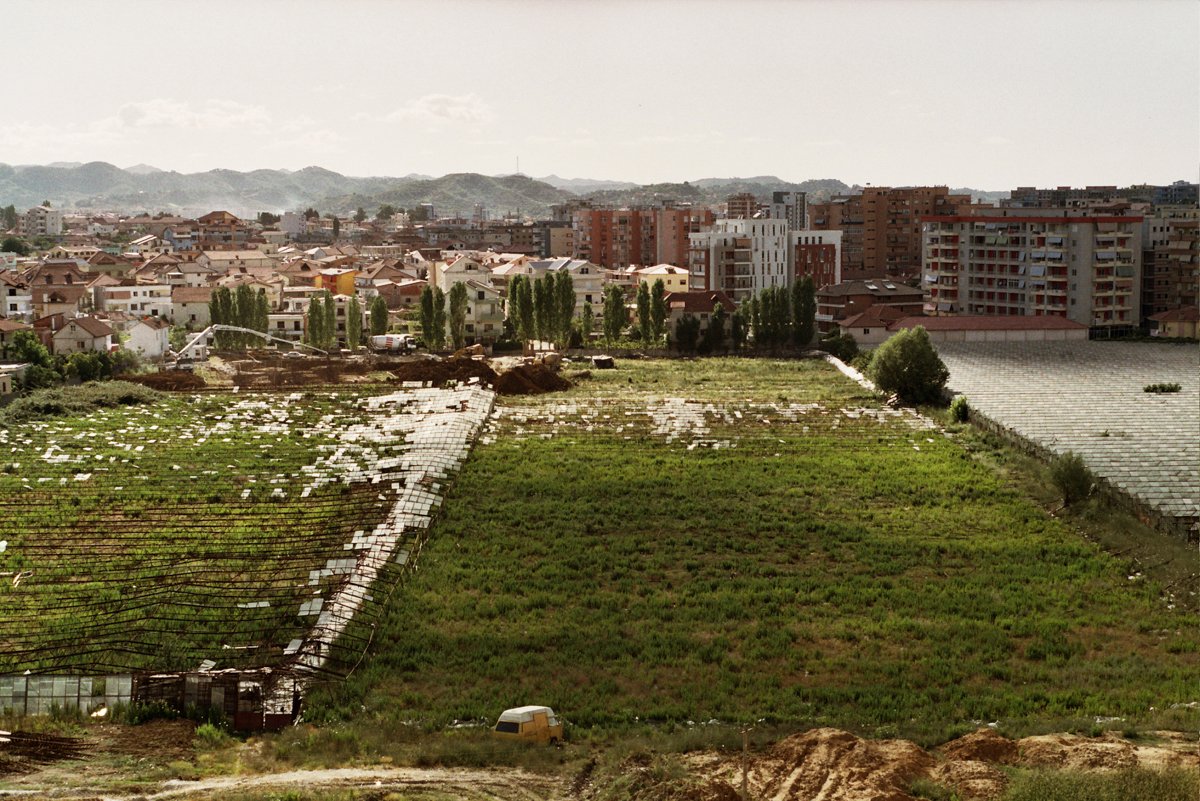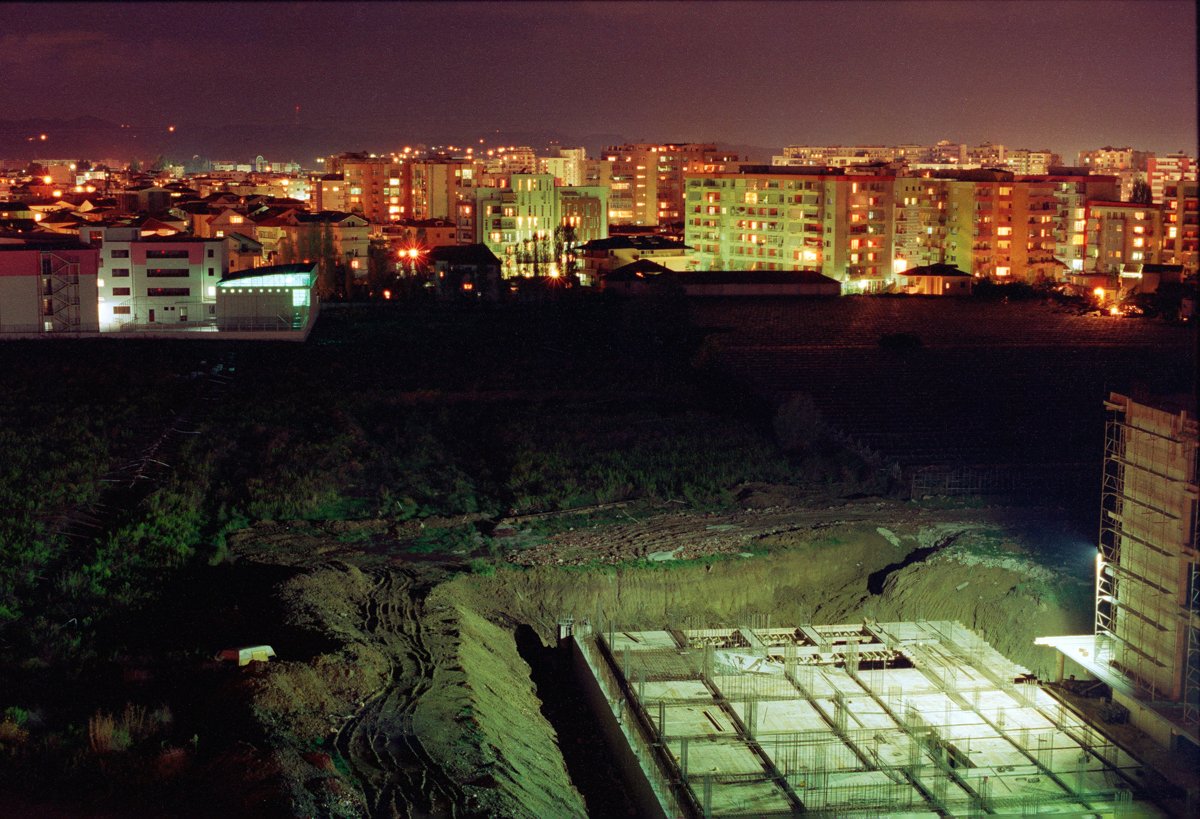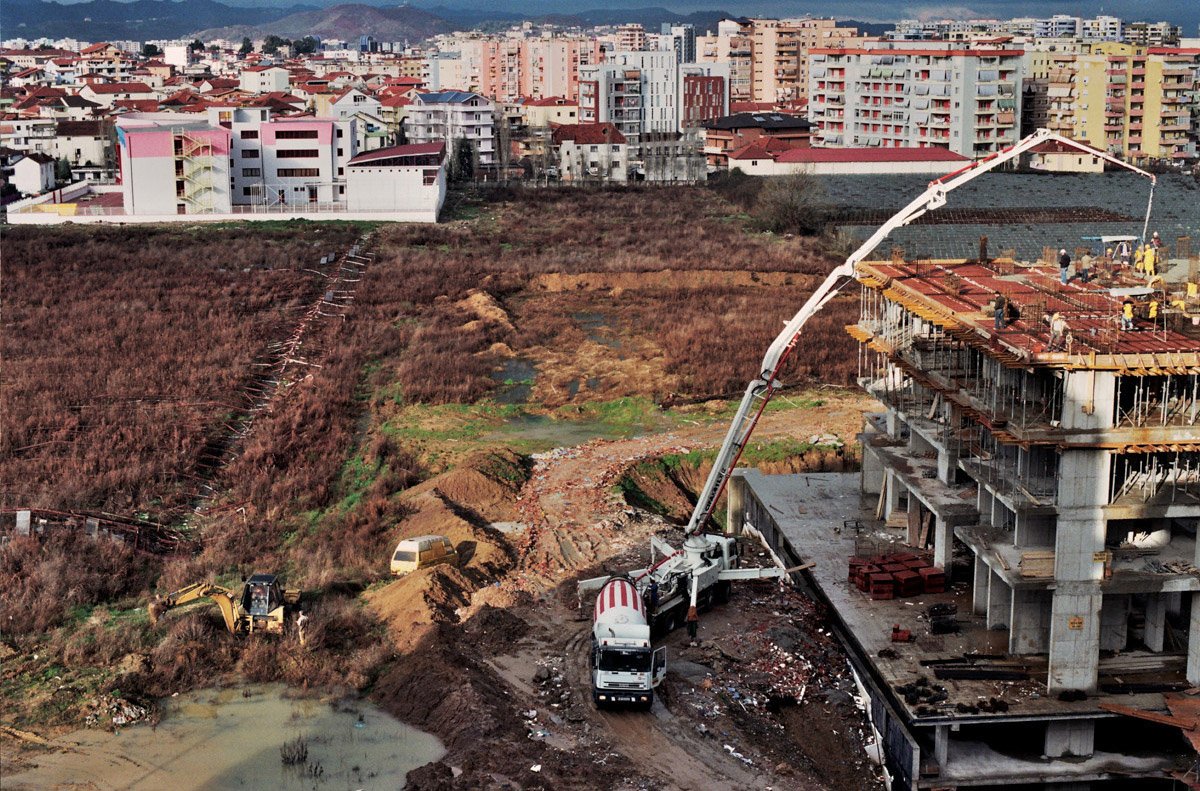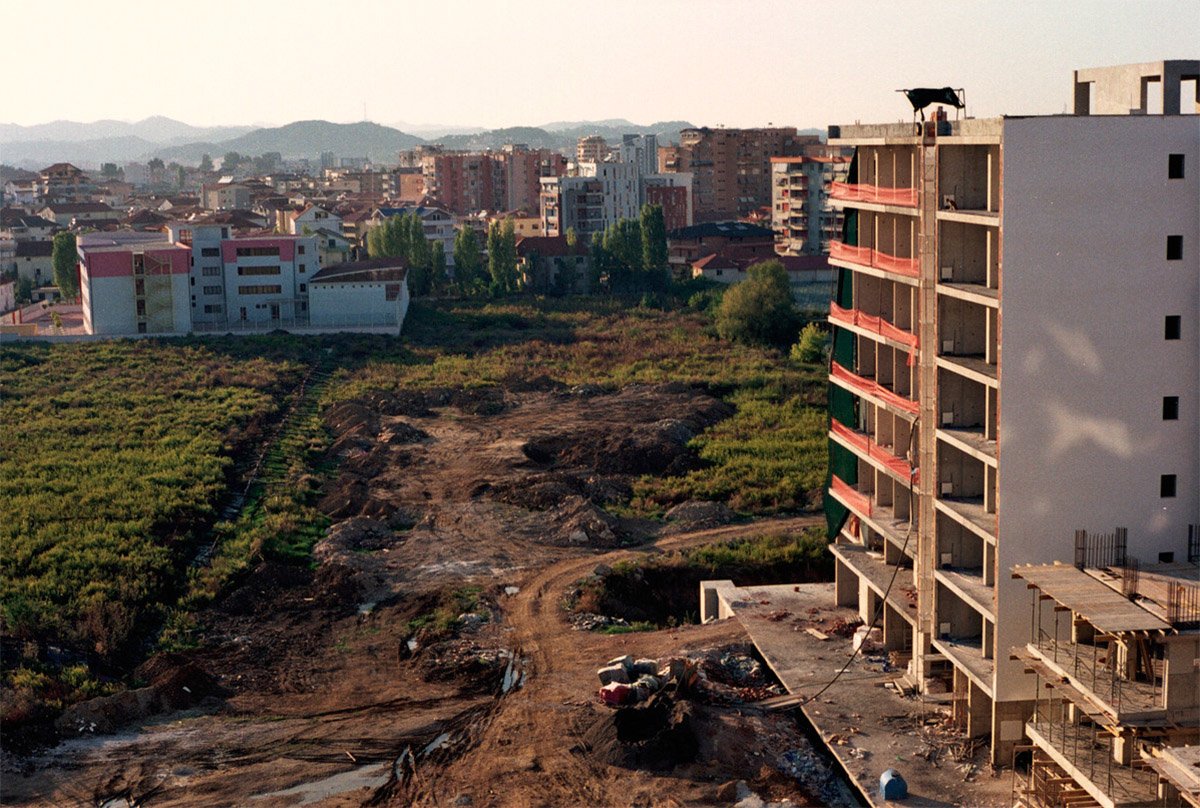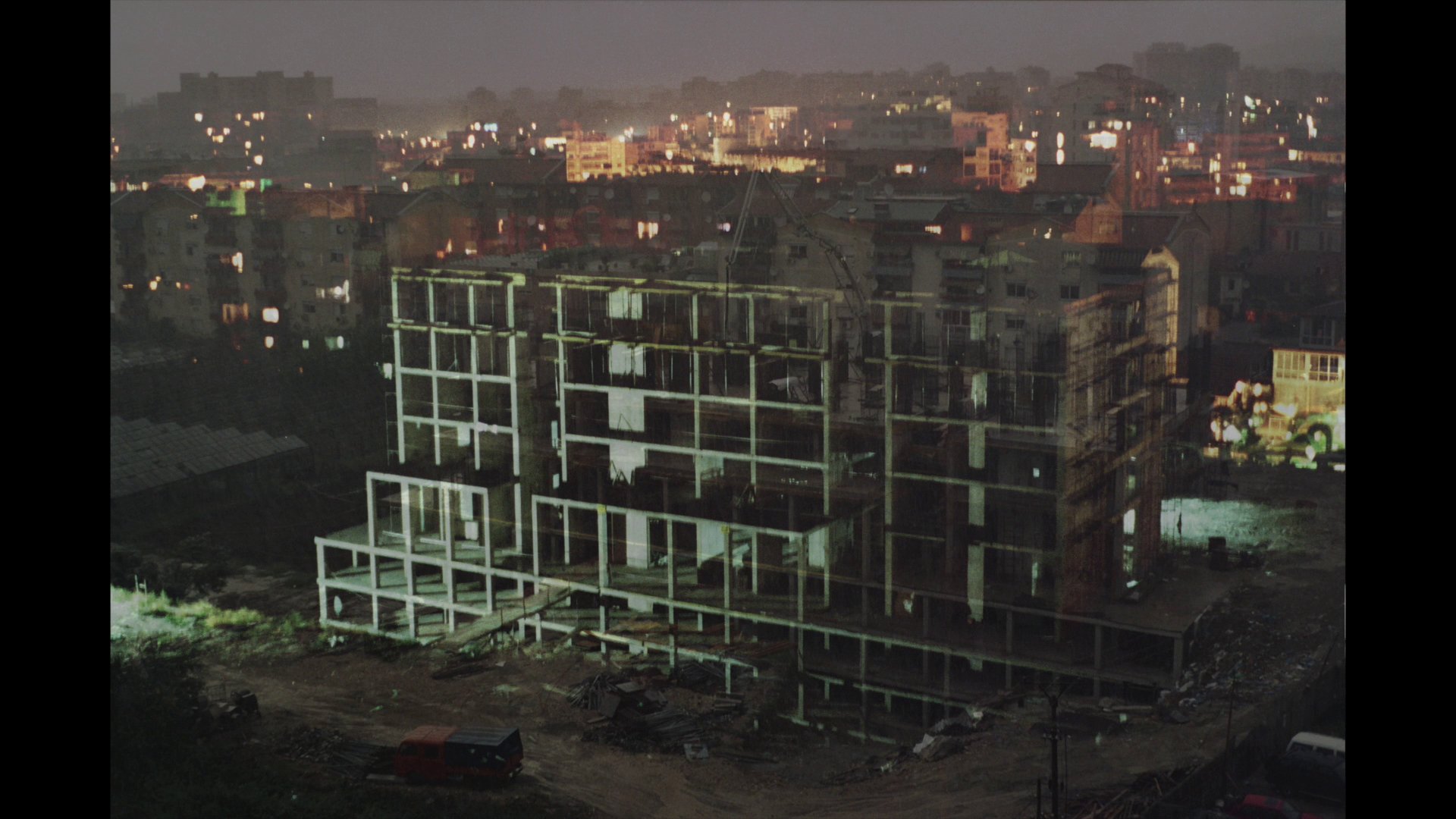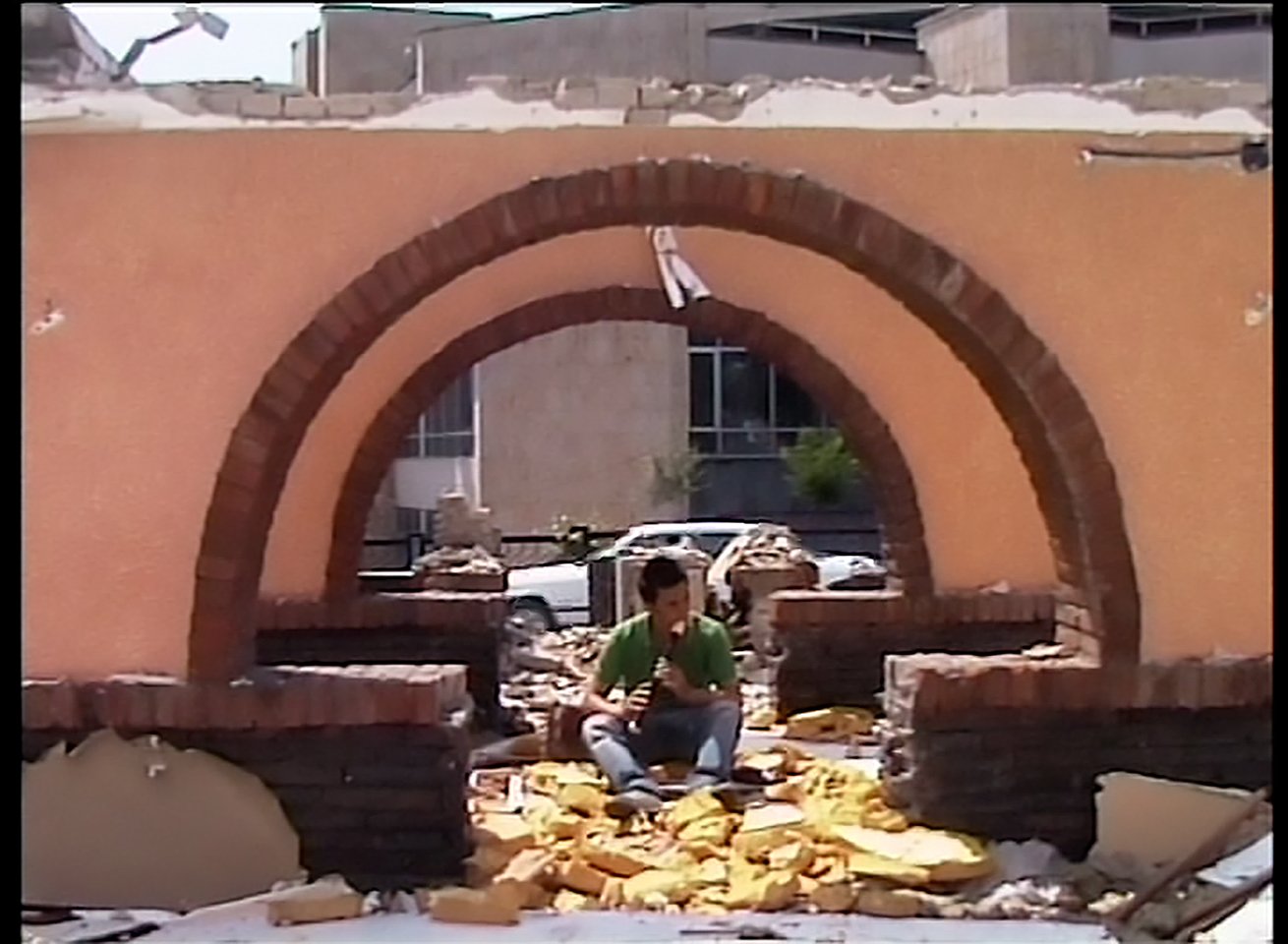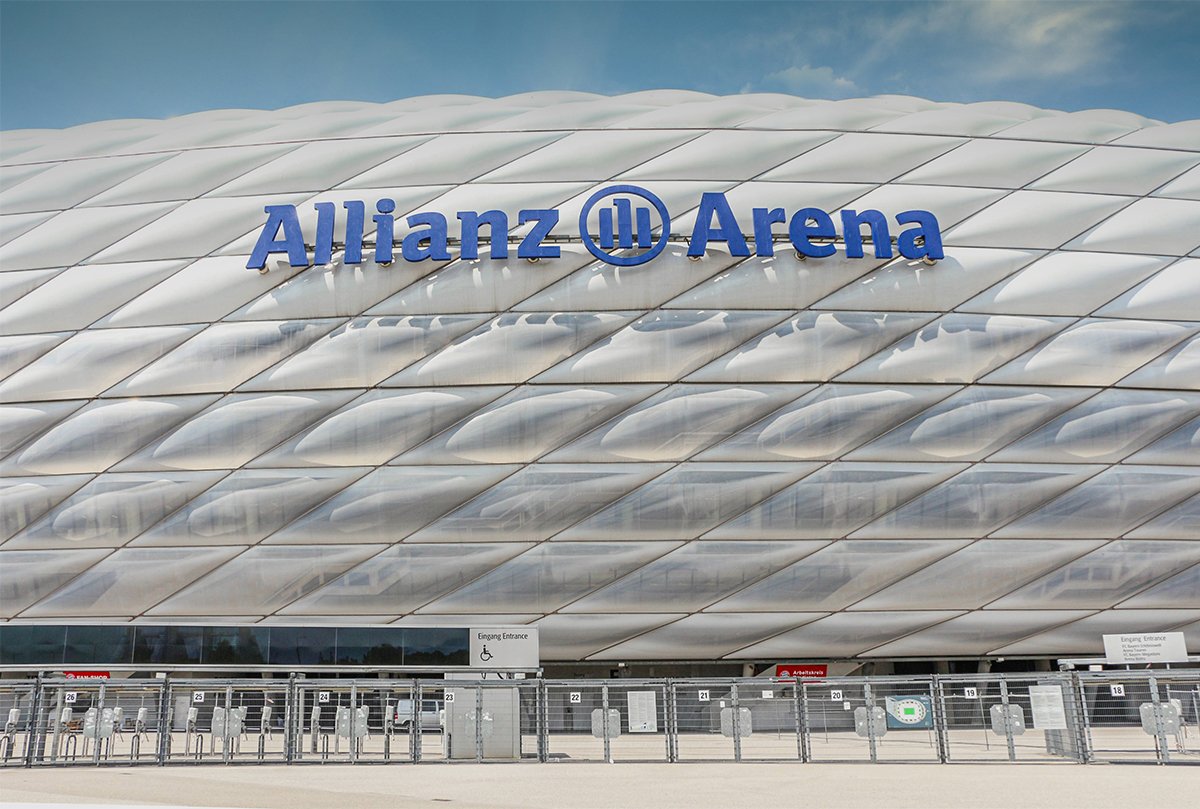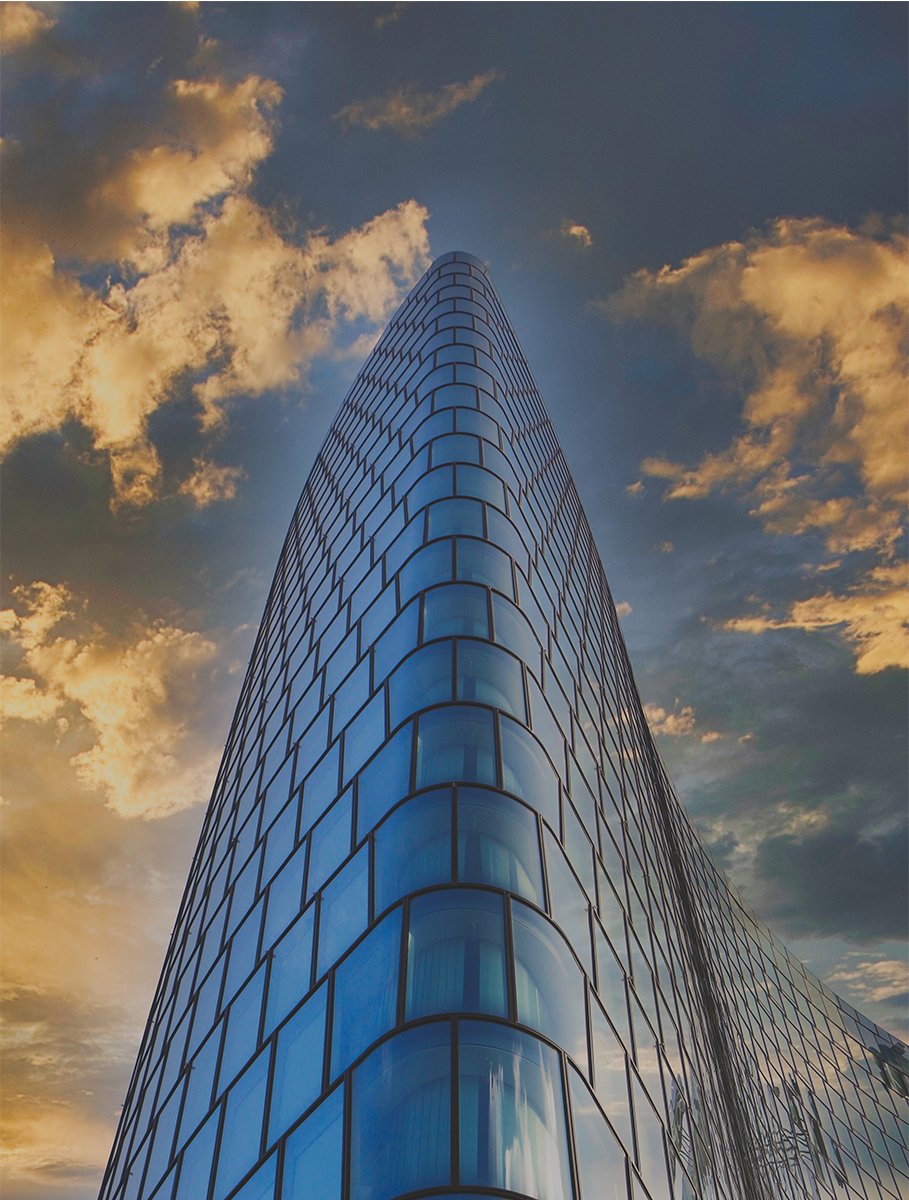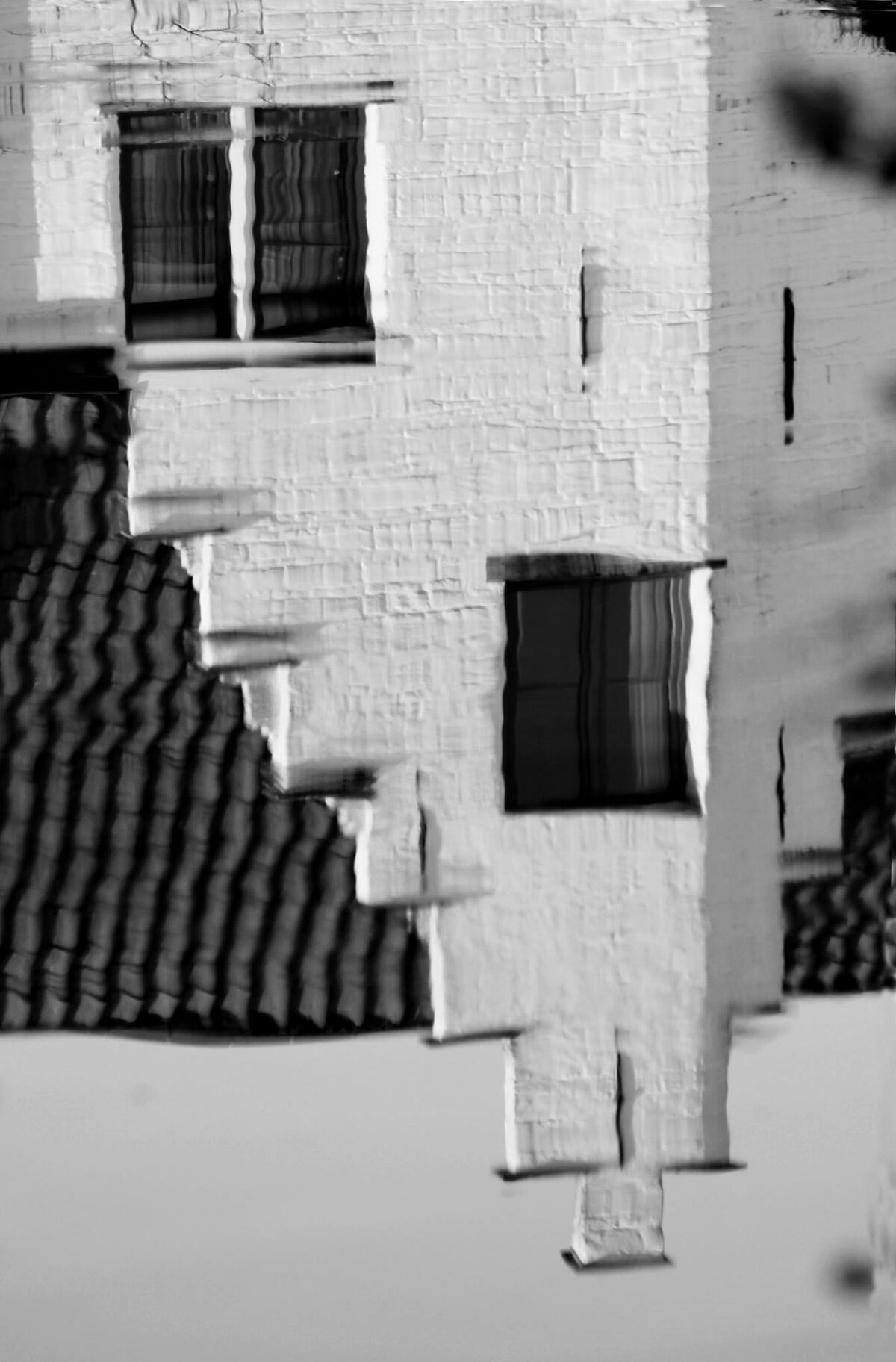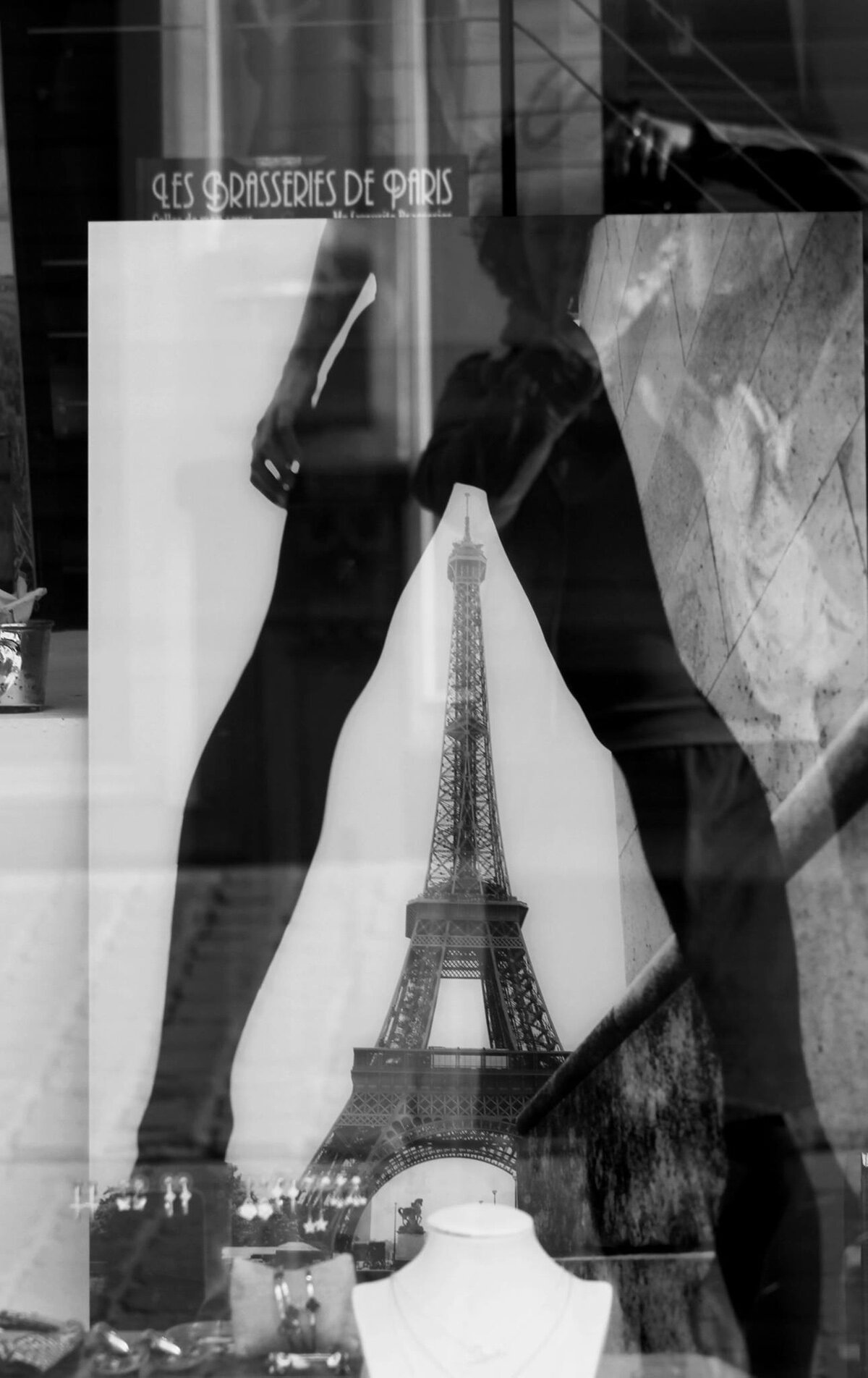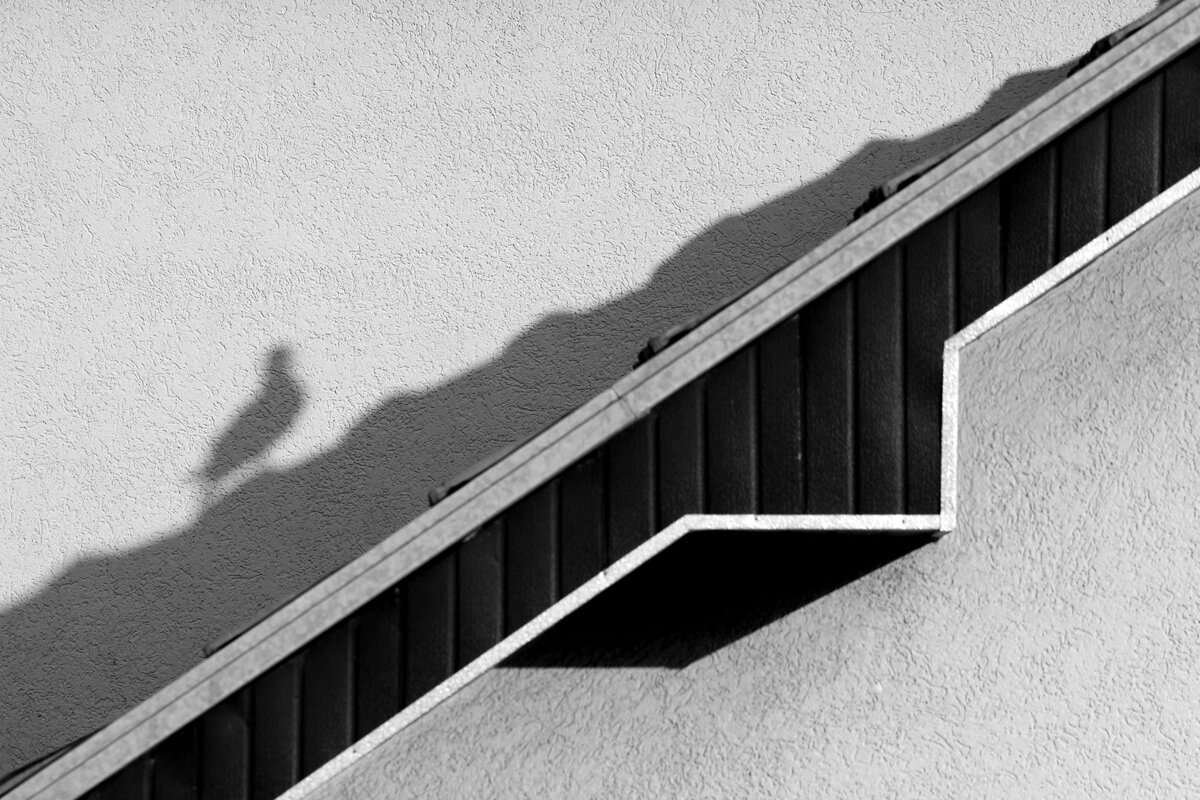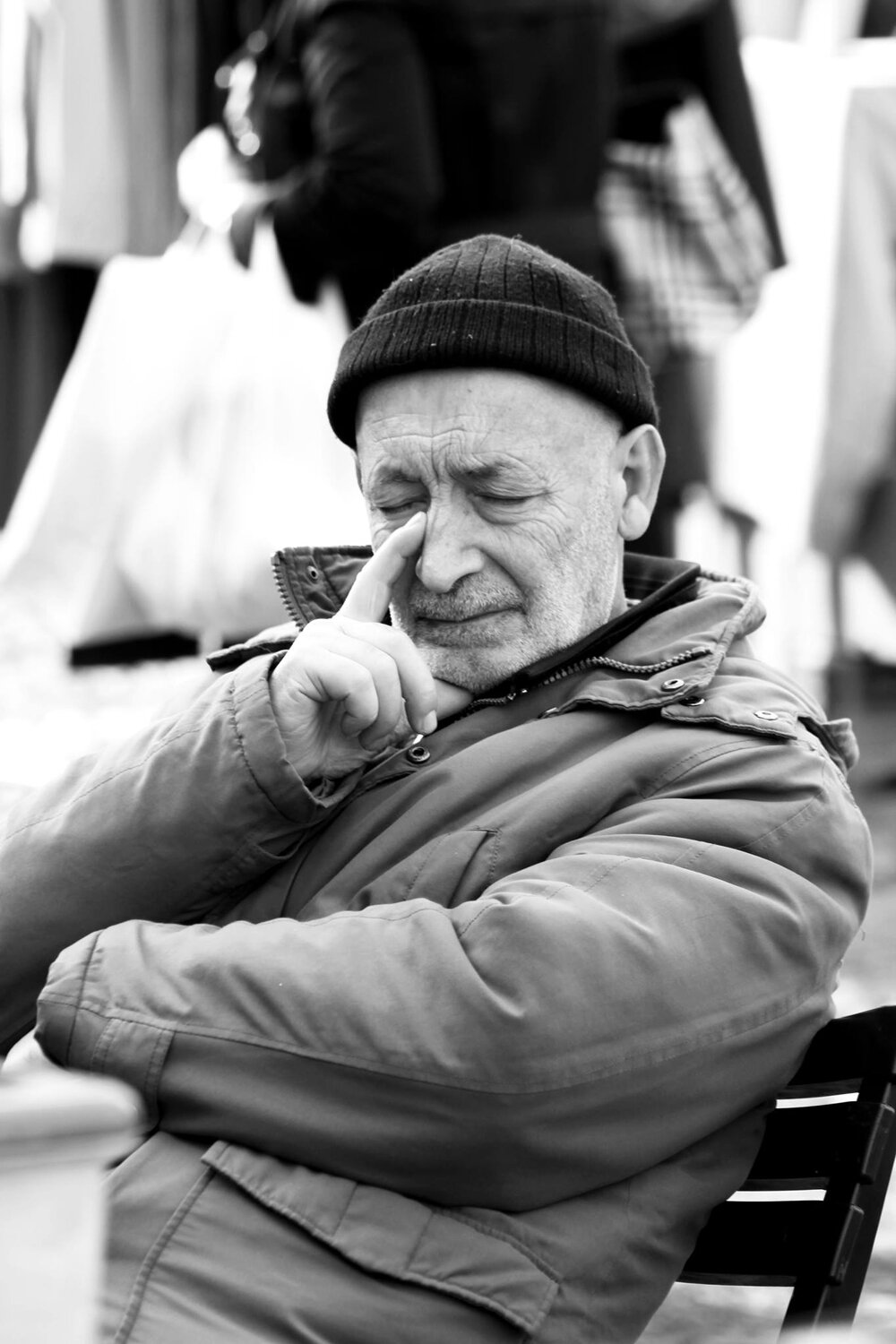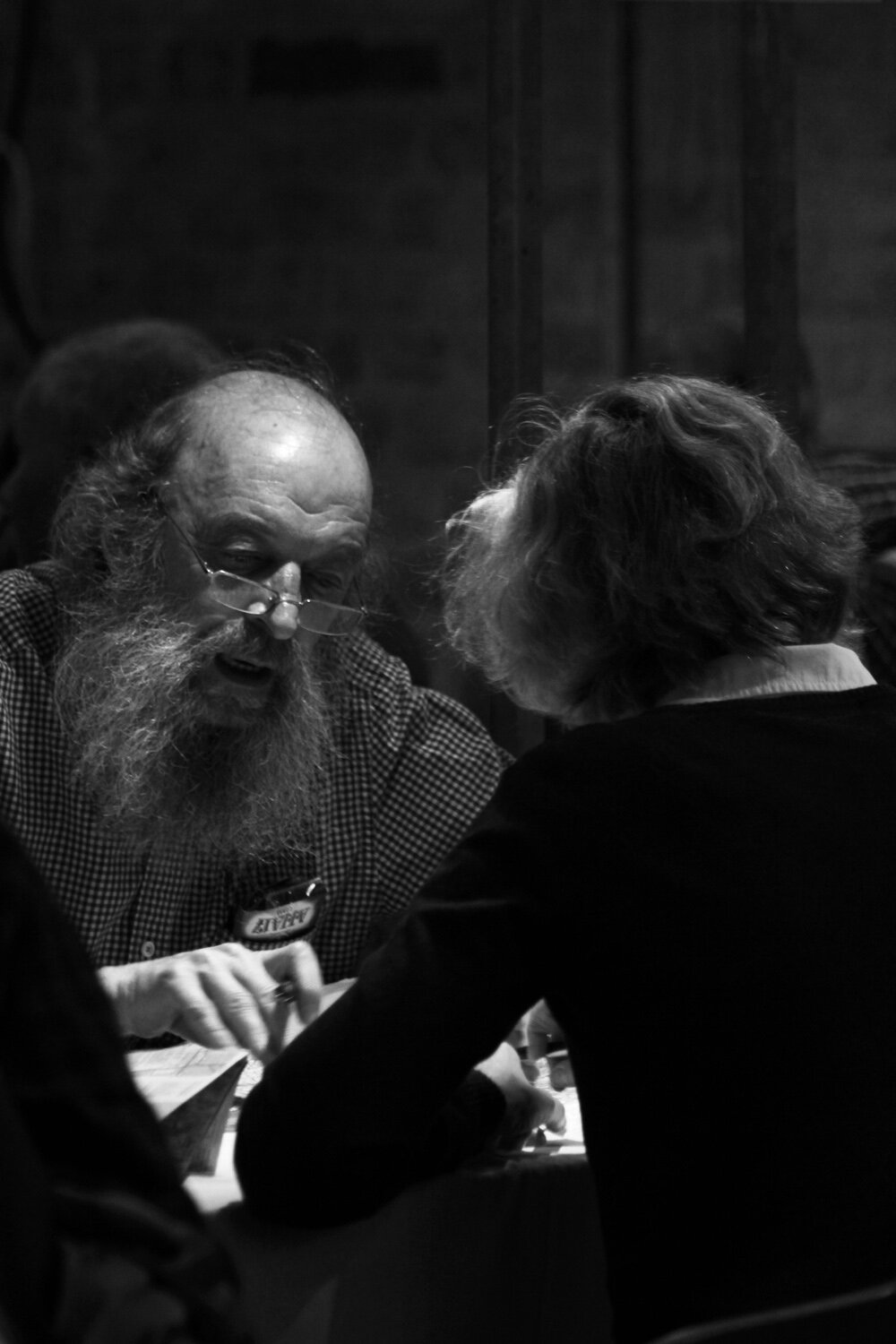Leonard Qylafi
Leonard Qylafi (b. 1980) is an Albanian visual artist, whose practice explores several mediums such as photography, painting, video and music, where the theme of the City and its Architecture occupies a certain role. The Photography and Video Projects that reflect on the transformation of urban spaces are (real) ESTATE, Estate, Whispers & Shadows, Solo Show.
Leonard Qylafi (b. 1980) is an Albanian visual artist, whose practice explores several mediums such as photography, painting, video and music, where the theme of the City and its Architecture occupies a certain role. The Photography and Video Projects that reflect on the transformation of urban spaces are (real) ESTATE, Estate, Whispers & Shadows, Solo Show. Deeply linked with personal experience, Leonardi's artworks are a process of research and meditation between subjects and mediums. Since his graduation from the Academy of Fine Arts in Tirana, the Atelie of Painting 2003, Leonard Qylafi has been present in the local and international art scene. During the last years his works have been shown in several galleries and international events, such as: Centre de création contemporane, Olivier Debré, Tours-France (2021); Belvedere 21 Vienna, Austria (2019); NiMAC Cyprus (2018); National Gallery Tirana, Albania (2017); MuCEM, Marseilles, Izolyatsia, Kiev in (2016); The 55th October Salon, Belgrade (2014); Künstlerhaus Bethanien, Berlin and Kunst Raum Riehen Basel/Switzerland (2012); MODEM Centre for Modern and Contemporary Arts, Debrecen, Hungary (2011); TICAB-Tirana International Biennial of Contemporary Art, Bjcm- XIII Biennal of young artists from Europe and Mediterranean, Puglia, Italy and ISCP- New York /USA in (2009) among other places. His work is published internationally and is collected by; The Albanian National Gallery of Art, MuCEM- Musée des Civilisations de l'Europe et de la Méditerranée, Marseille; Contemporary Art museum Belvedere 21, Vienna, video collection and several private collections. In 2017, Leonard Qylafi represented Albania in the 57th edition of the Venice Biennale, with the multidisciplinary project "Occcurrence in the Present Tense" curated by Vanessa Joan Müller. I am very pleased that Leonardi accepted to be interviewed for Tatì Space and talk about his projects in regarding Architecture and Urban Photography.
Alketa Misja for Tatì Space: Hello Leonard. You are a visual artist who explores several mediums, among them Photography and Video. What is the place Photography occupy in your artistic practice? How did you become interested in Urban and Architecture Photography?
Leonard Qylafi: My interest in photography came when I was studying at the Academy of Arts, in the painting atelie. Until then I had an art school education, focusing on drawing and painting. Photography was new to me and took time to master technically and use as a medium for special projects. What I can say is that it has had a huge impact on my practice as an artist either directly or indirectly and remains present in my work. Mainly, special projects that I have realized in photography have always been solutions started from a conceptual approach. In the case of urban photography, it has naturally been part of projects that focuse on urban transformations.
Tatì Space: What is your approach, in respect to Architecture and Urban Photography? You have several projects about the new construction in a rapidly growing city like Tirana. What is the idea, the concept behind these works?
Leonard Qylafi: I have been dealing with urban photography mainly in function of the artistic projects that I have developed. Around 2007-2011, urban space has taken an important place in my projects. The (Real) Estate and Estate projects are based entirely on photography, even though Estate is a photo animation turned into a video. Other projects always with the same theme have been in the form of videos such as Private Show or Whispers&Shadows. In each of them, a special aspect of the relationship we have with the space we live in is addressed, and in particular the idea of change and memory in relation to what we call Polis or city, as a complex entity and an expression of the culture and worldview of human society.
Tatì Space: How do you see the artistic scene in Albania in relation to Urban Photography? (if you can share an opinion). The photo can provoke a thought or nurture a discussion about city's problems. In this sense, what advice can you give to young photographers who want to explore urban and architecture photography?
Leonard Qylafi: Looking at the artistic scene in a general view, I can say that unfortunately there is a total lack of spaces, structures that are necessary for the promotion and exposure of art as a whole and of course contemporary photography. This makes it difficult to recognize and introduce new artist-photographers. The other part that makes it even more difficult, in the case of photography in particular, is its massification as a practice with the development of technology. It would be necessary to create special structures with a focus on photography. Regarding urban and architectural photography, I can say that Tirana today is a very rich subject to explore. I would suggest young photographers to see it as a unique opportunity on which to build their research either in terms of the city as a subject or architecture in particular.
Tatì Space: Thank you Leonard, We wish you all the best for your artistic plans and projects.
Below we give a summary of Leonard Qylafi's works, with regard to Urban and Architecture Photography, focused on theme of City and construction developments.
(real) ESTATE
(real) ESTATE, courtesy of Leonard Qylafi
The series of photographs were developed within a three year period and together with the video works Estate and Whispers & Shadows reflect on the transformation of the urban space in Tirana. In this particular project that was the starting point of my research on this topic the documentary style of photography plays the role of the critical awarnes of how the space is transformed. How a different ecomomic and political system overlapes a previous one. The greenhouse use to exist in suburb of Tirana during the communist regime and now is in a middle of a new neighborhood . This masive transformation more than having a shocking effects rises the question of how much do we participate as people living in a city. Do we decide how this city should be shaped to fit our needs ? Unfortunately the people don't play any role but the spectator.
Whispers & Shadows / 2011 / Video installation / Standard Pal 4:3 aspect with sound / 5:24 min/sec
Fragment from the Video installation “Whispers & Shadows” / 2011 / Standard Pal 4:3 aspect with sound / 5:24 min/sec. courtesy of Leonard Qylafi
The ambiance of the site introduces the viewer with the happening; constructions machines excavating in the ground covered by the darkness of the night. Their loud noises give place to a female voice reading selected text by Aristotle’s Politics. The verses which speak about Polis and the sense of living together sound utopia in the today machine-like model of urban centre where the role of the public seems to get eclipsed somehow. The ideal of living together, sharing the goods and the space sounds like millenniums away indeed, once the noise of the machines is firmly back.
ESTATE / 2007 / Video installation / Full HD (no sound) / 8:58 min/sec
Fragment from the Video installation ESTATE / 2007 , Full HD (no sound) / 8:58 min/sec courtesy of Leonard Qylafi
The silent animation lump numerous photographs making this way notes of the construction process of a massive building. The perceptive aspect of the process becomes a key element of the work. The physical time of a two year process of construction is concentrated in nine minutes of animation but it does so by challenging the viewer attention with an apparently freeze look.
Private show / 2006 / Video installation / Standard Pal 4:3 / Music by Leonard Qylafi / 3:19 min/sec
Fragment from the Video installation “ Private show”, 2006, Standard Pal 4:3 / Music by Leonard Qylafi / 3:19 min/sec. courtesy of Leonard Qylafi
The relations we have with places is very complex and somehow impossible to describe in words. In Tirana where I live is very usual to see buildings demolished for building new ones. This violent transformation impacts the life of people living in the city. When you see that a building that you know is demolished the kind of shock you experience can not be described. This was also the case with the building that becomes the stage of my performance. I go there and play a short music piece I have composed as a memoriam to the relation I use to have with that place
To see more about author’s work on his website: www.leonardqylafi.com
PhotoBook "Albanian Scapes"
The Photobook "Albanian Scapes" is the first publication of Tati Space, with photographs by Alketa Misja and foreword by Andi Papastefani and Falma Fshazi. Now available on Amazon and Blurb Bookstore. A photographic journey into Albanian Landscape as seen from an architect and urban planner. A Landscape in a constant transformation under the pressure of human activities and rapid urbanization. A fragile landscape that will not be the same.
The Photobook "Albanian Scapes" is the first publication of Tati Space, with photographs by Alketa Misja and foreword by Andi Papastefani and Falma Fshazi.
Now available on Amazon and Blurb Bookstore
Amazon Store: ISBN Hardcover, ImageWrap: 9798881301958
Blurb Bookstore: ISBN Hardcover, ImageWrap: 9798881287856
Blurb Bookstore: ISBN Hardcover, Dust Jacket: 9798210988904
Language: English, Albanian
Standard Landscape, 10x8 inch, 25x20cm
100 pages, 87 photos, Premium Lustre Paper
A photographic journey into Albanian Landscape as seen from an architect and urban planner. A Landscape in a constant transformation under the pressure of human activities and rapid urbanization. A fragile landscape that will not be the same. The photos in this book cover a period of time from 2008 to 2022. This is the longest photographic project of Alketa Misja. Other photographic projects from the same author are Artifact Project - Photographing the Industrial Heritage of the Socialist Period and Photographing Modern Architecture in Albania.
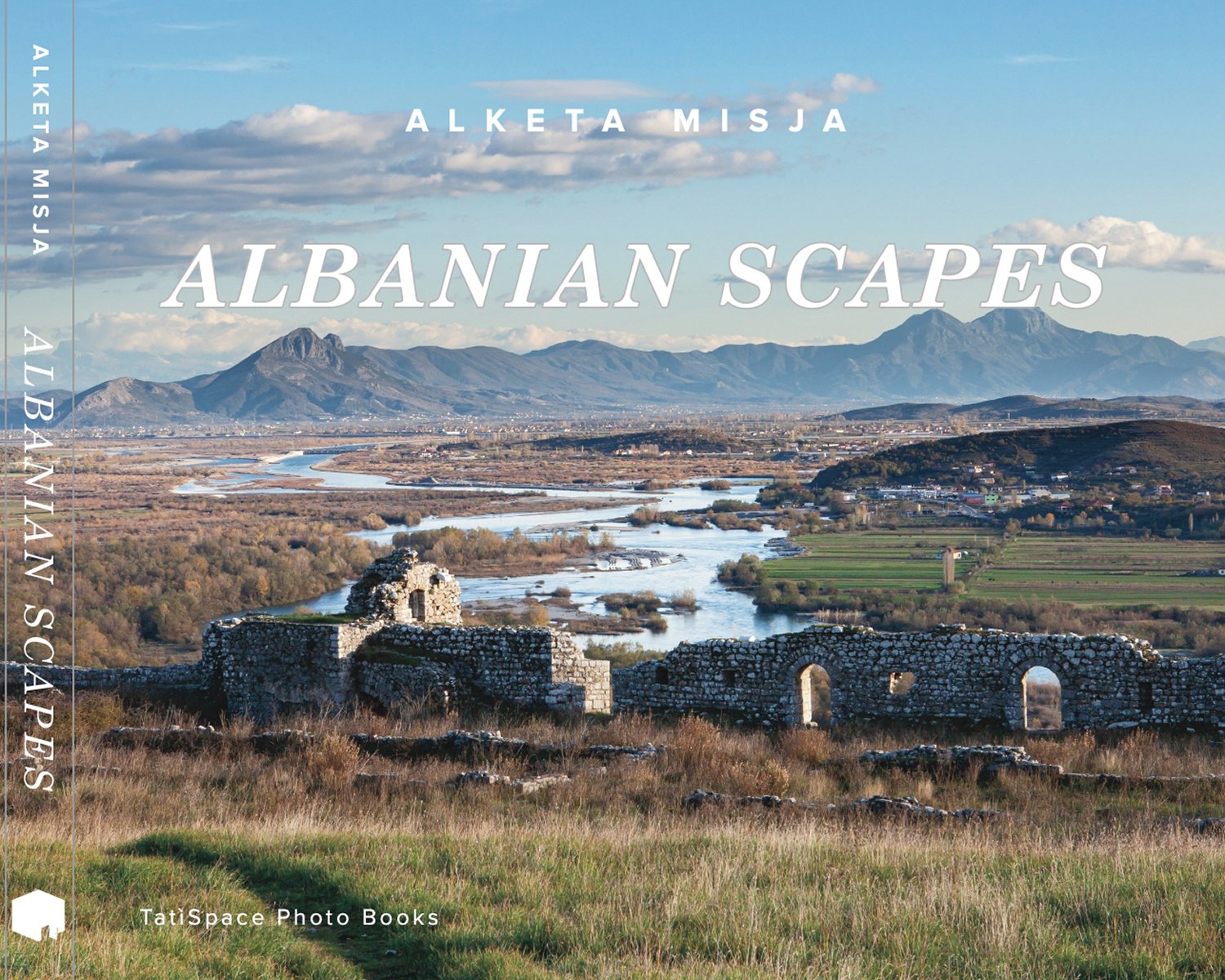
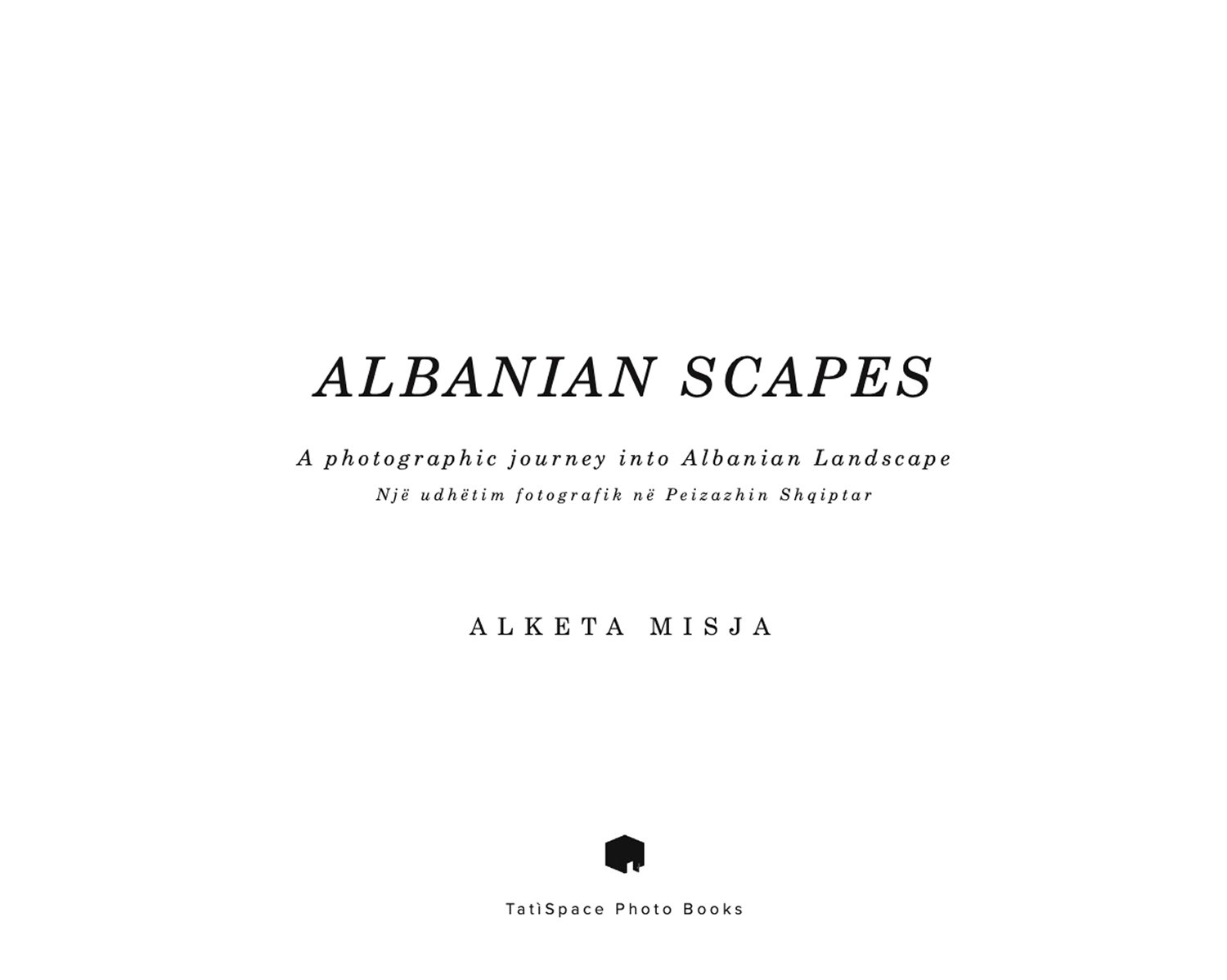
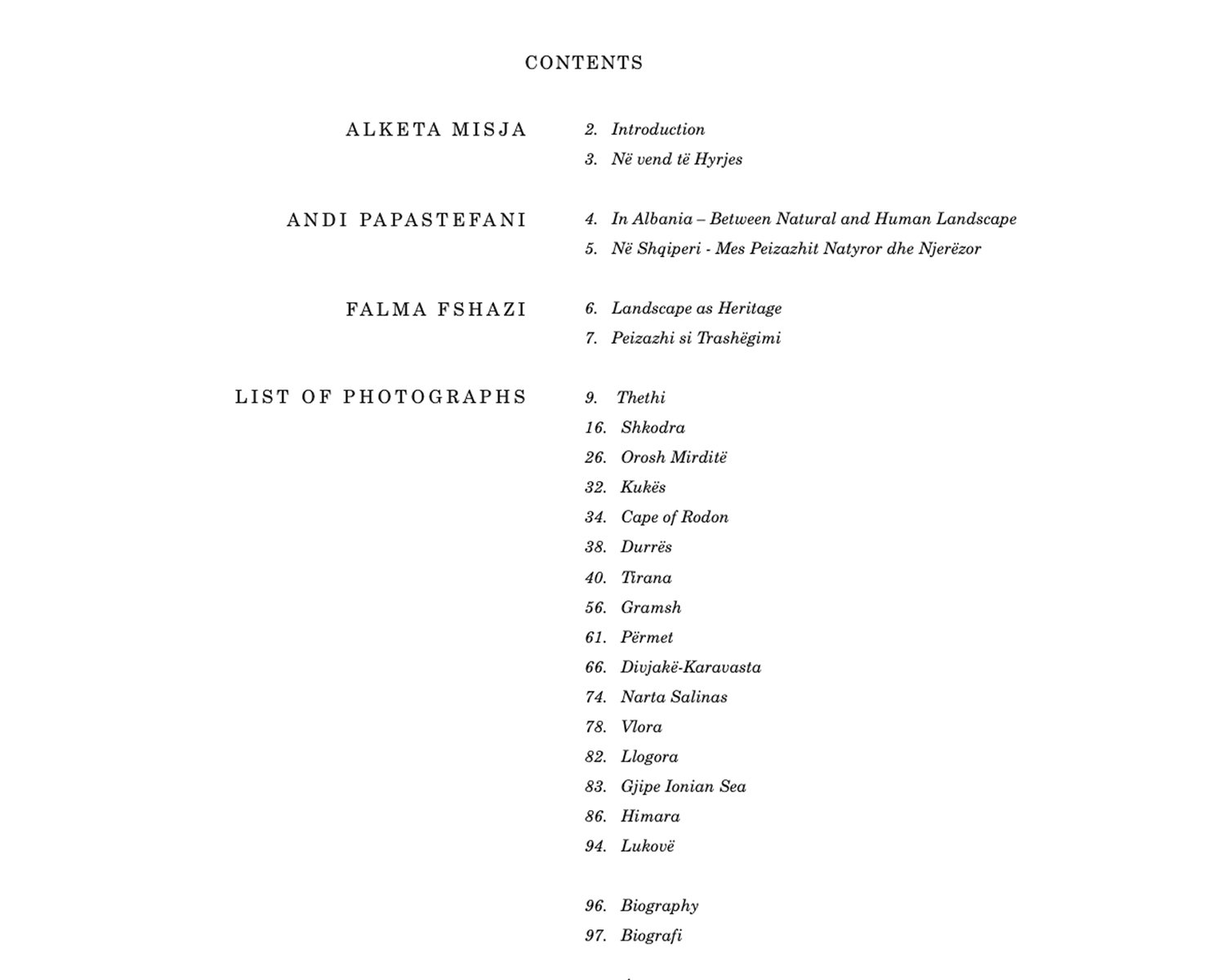
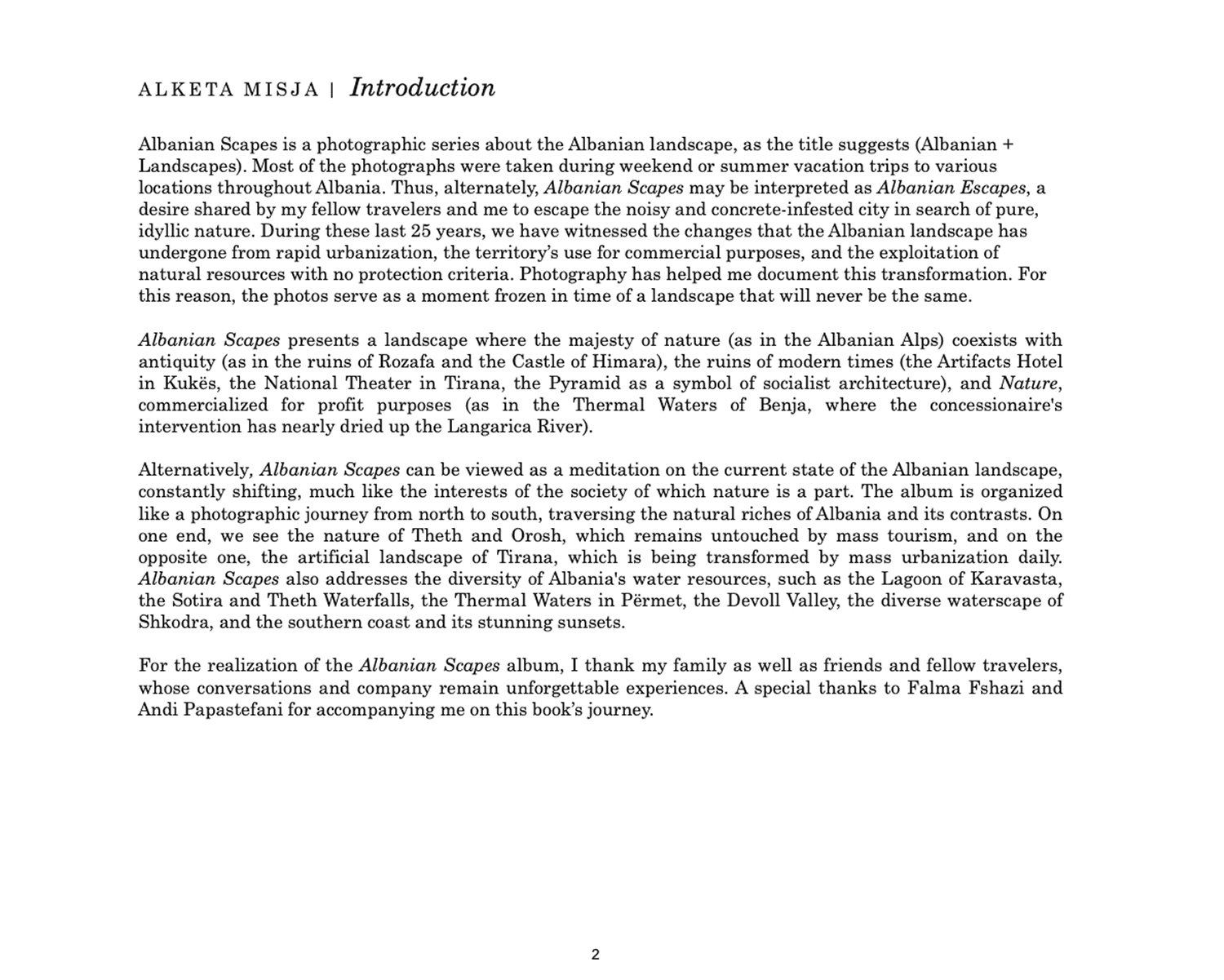

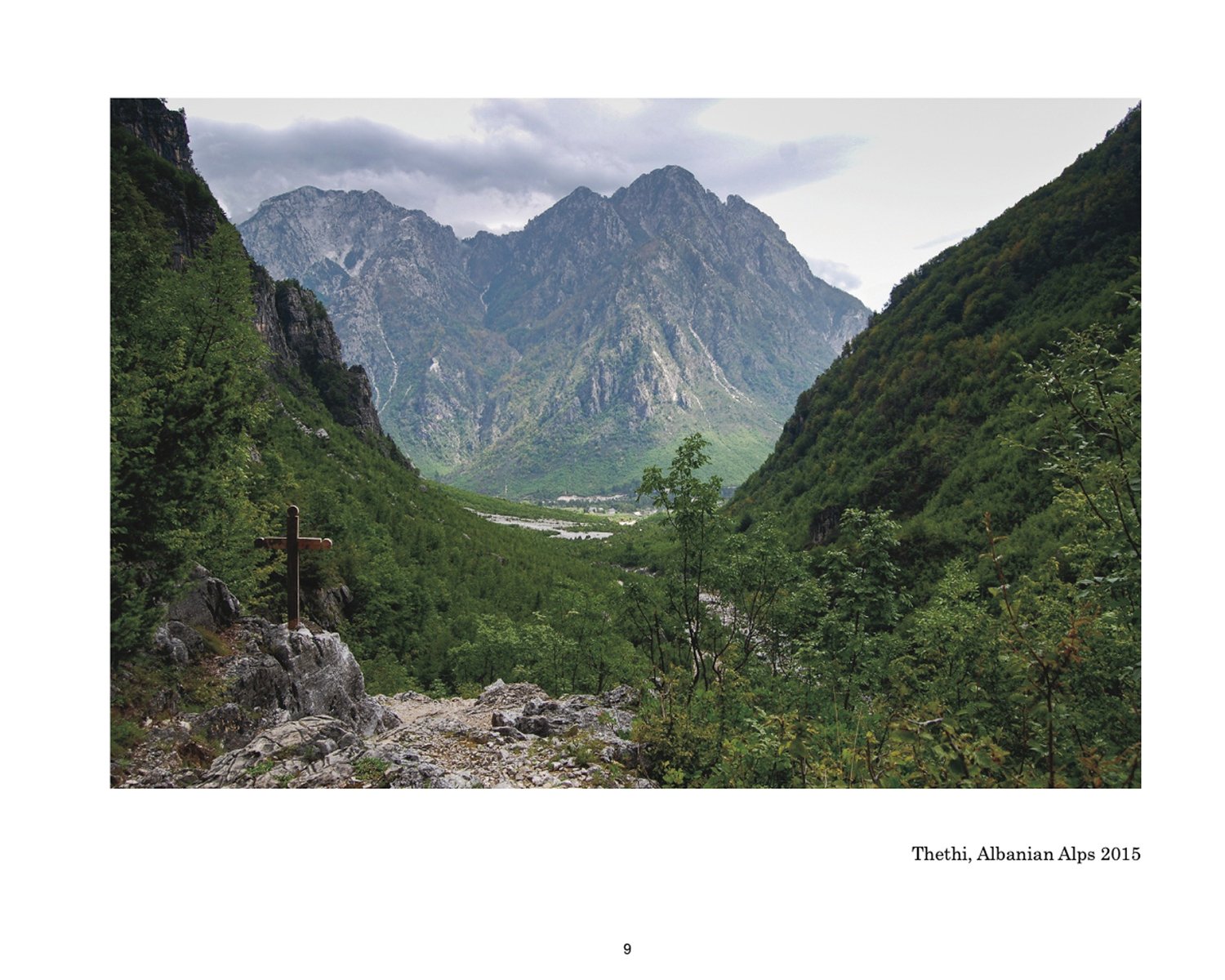
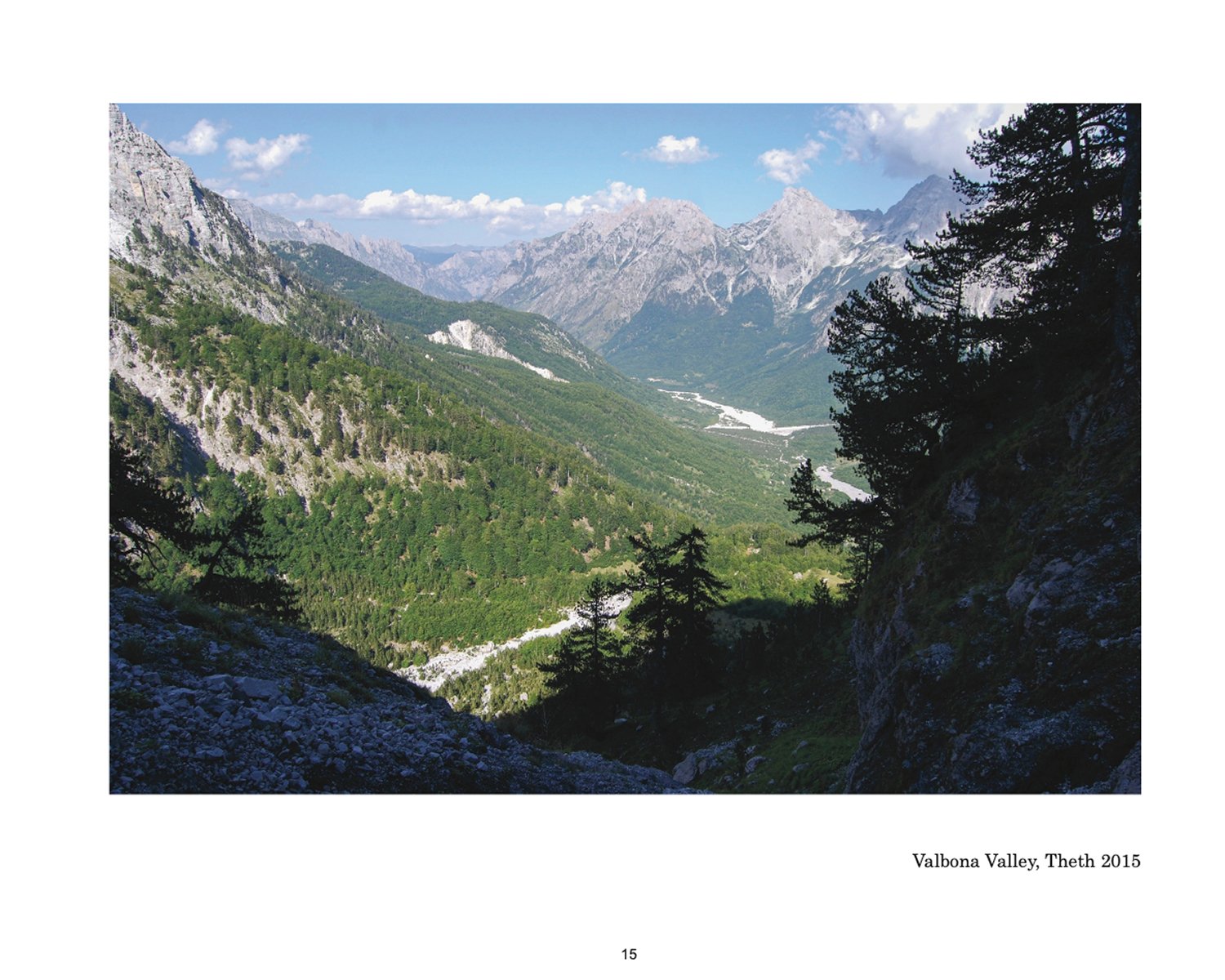
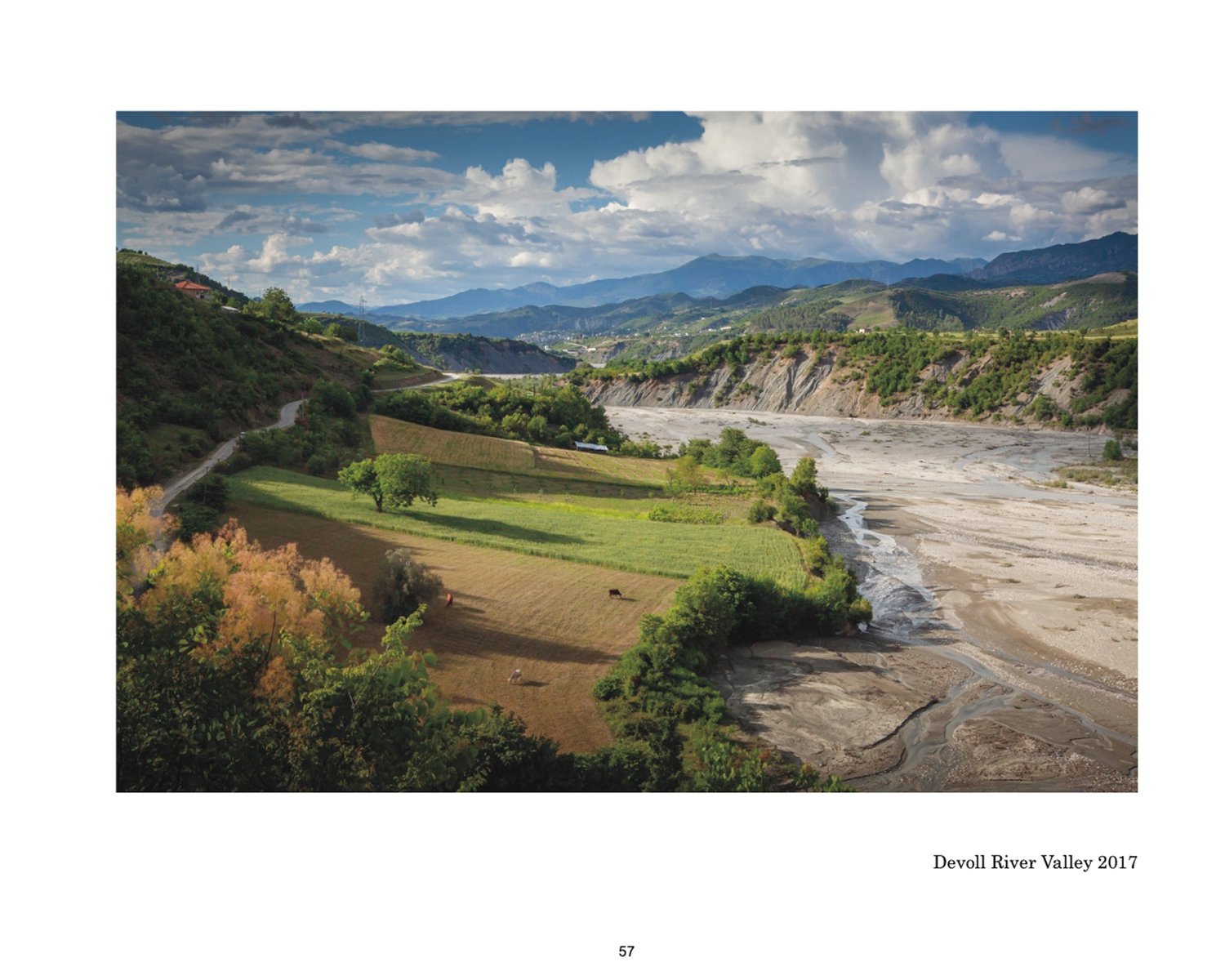
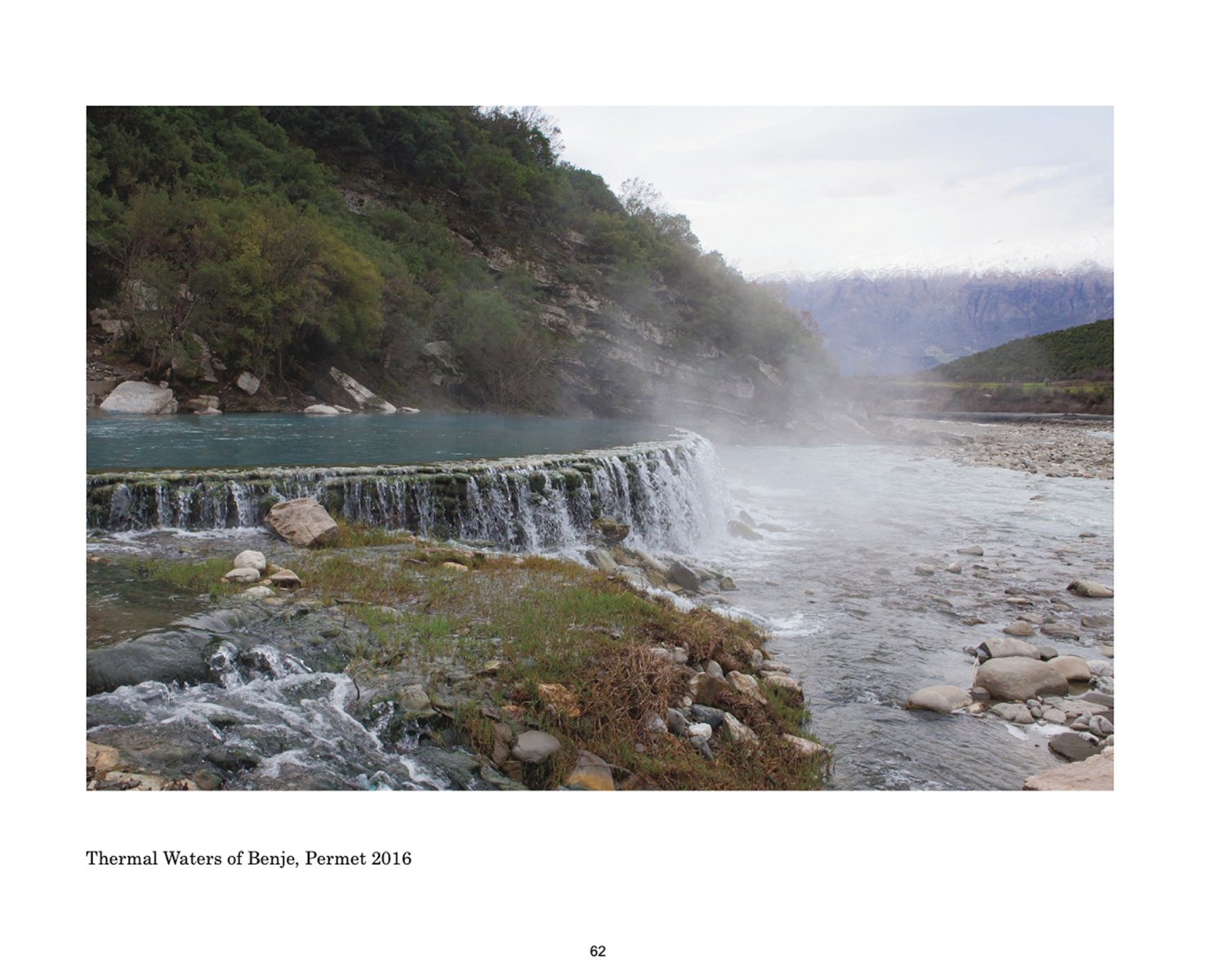
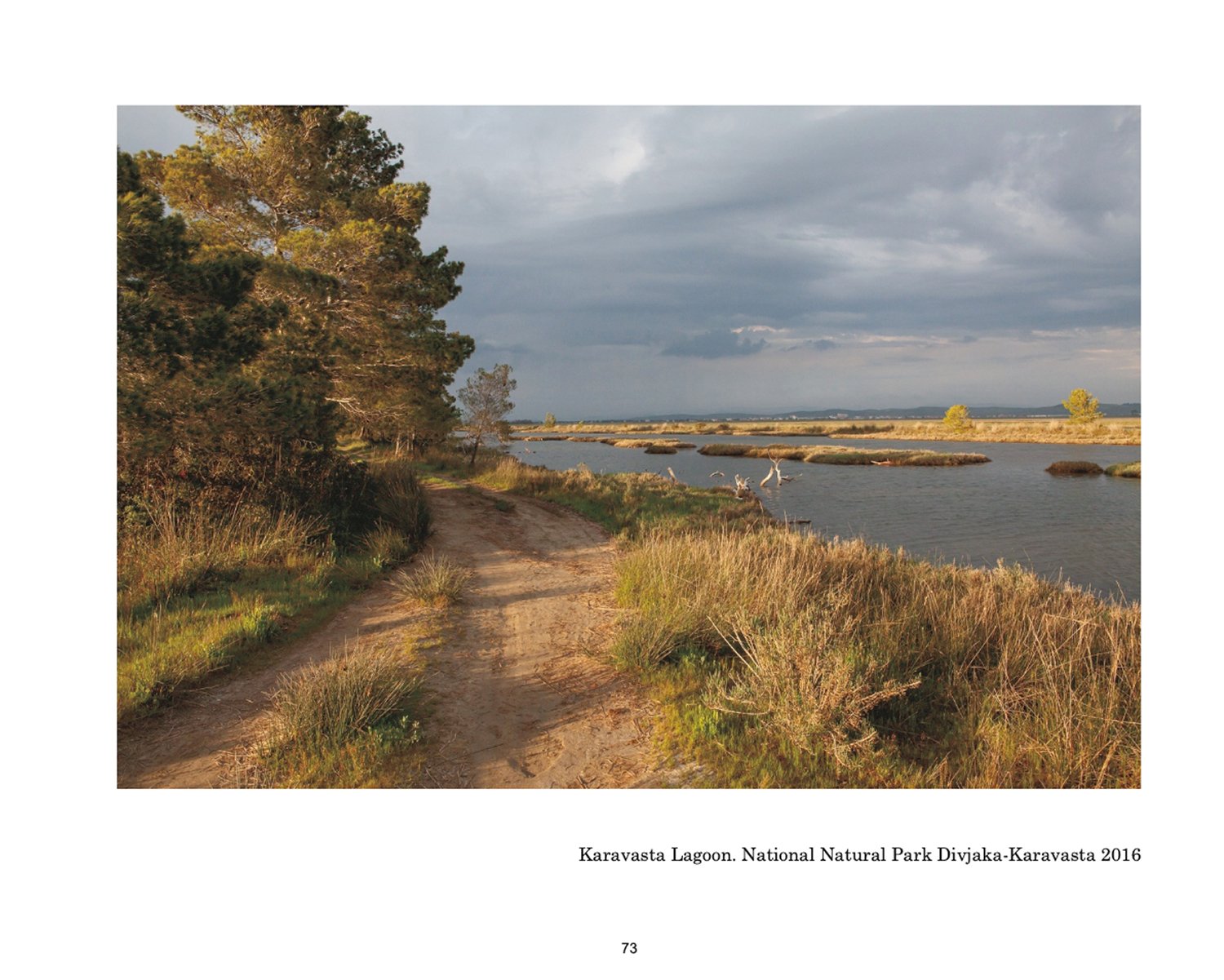
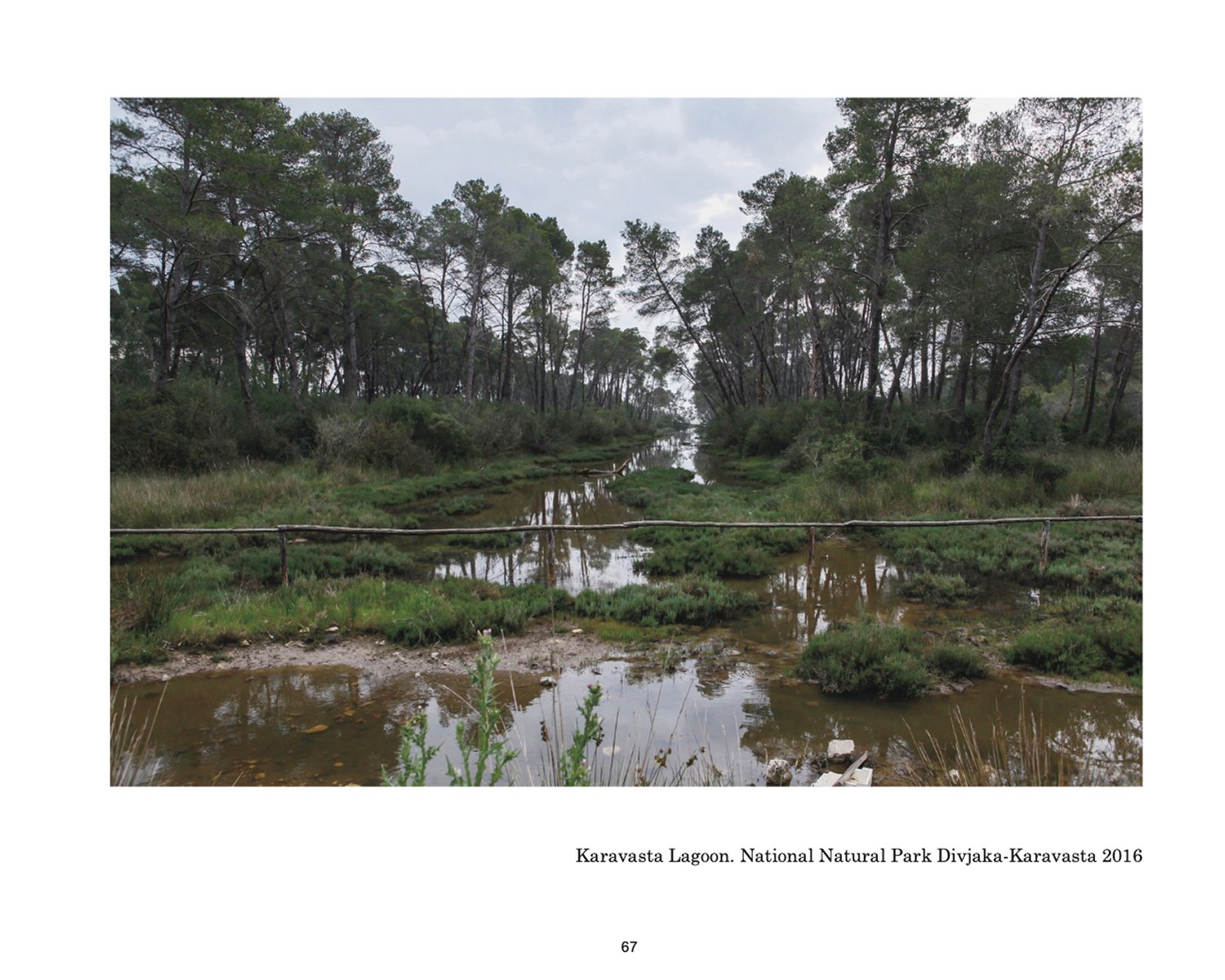
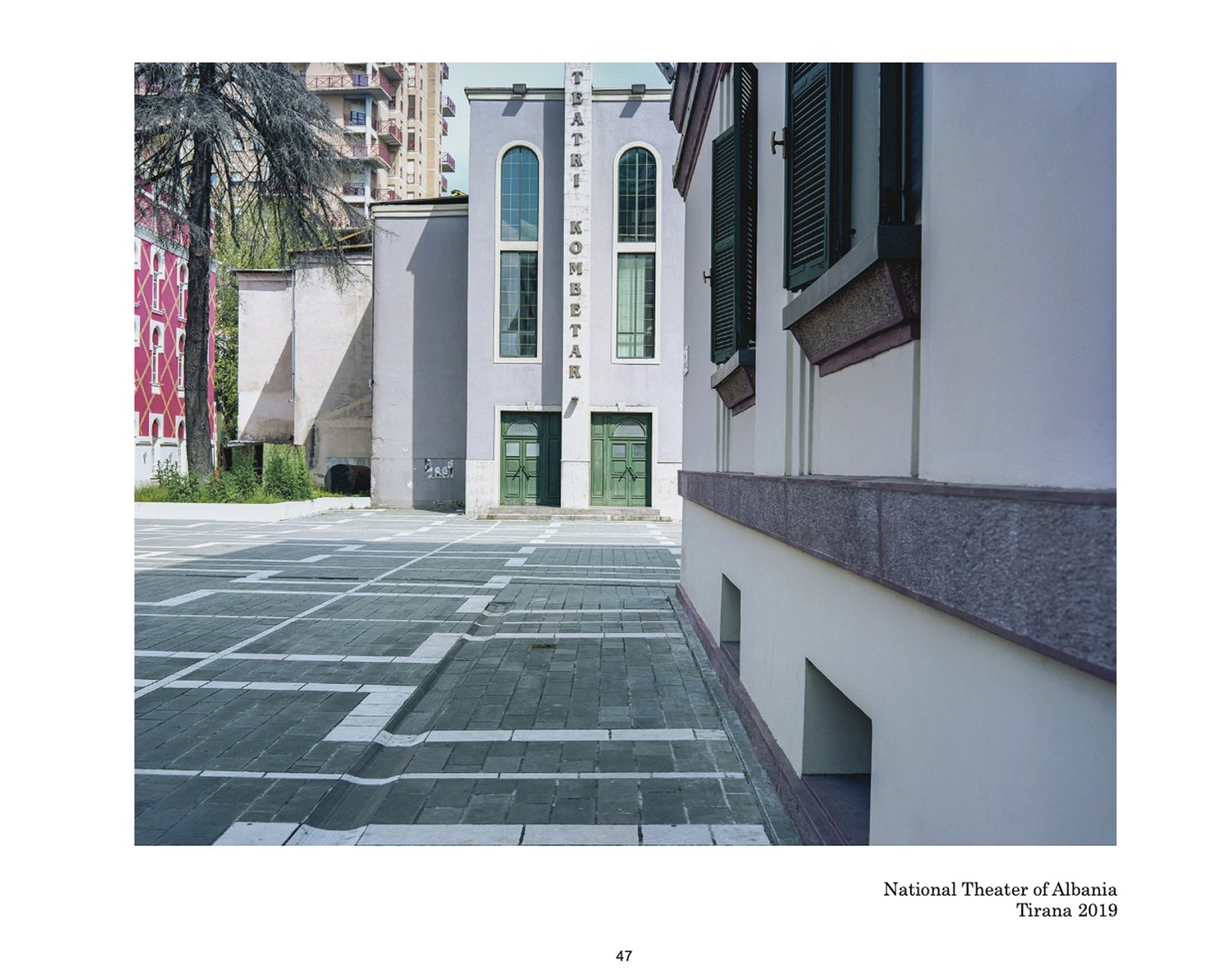
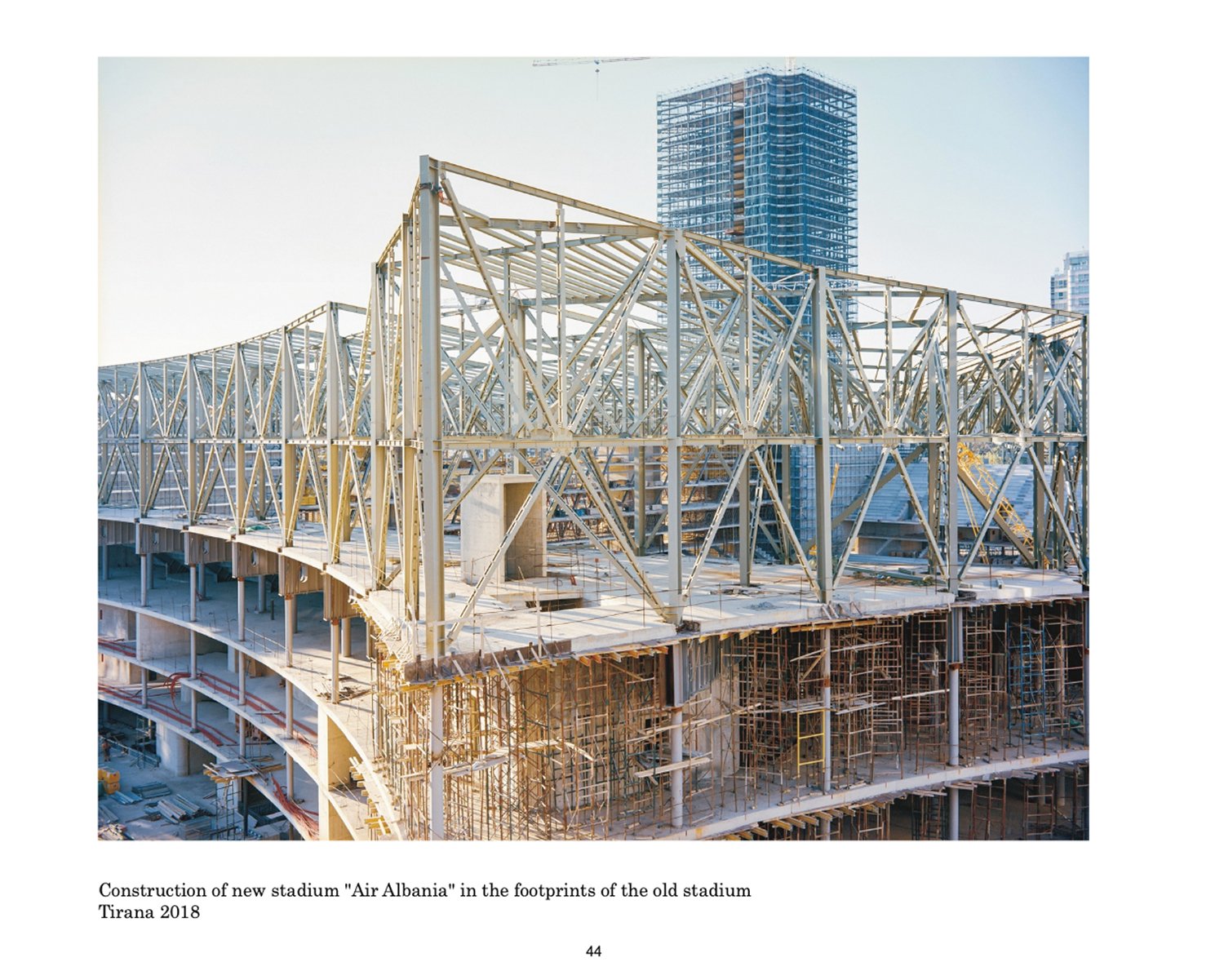
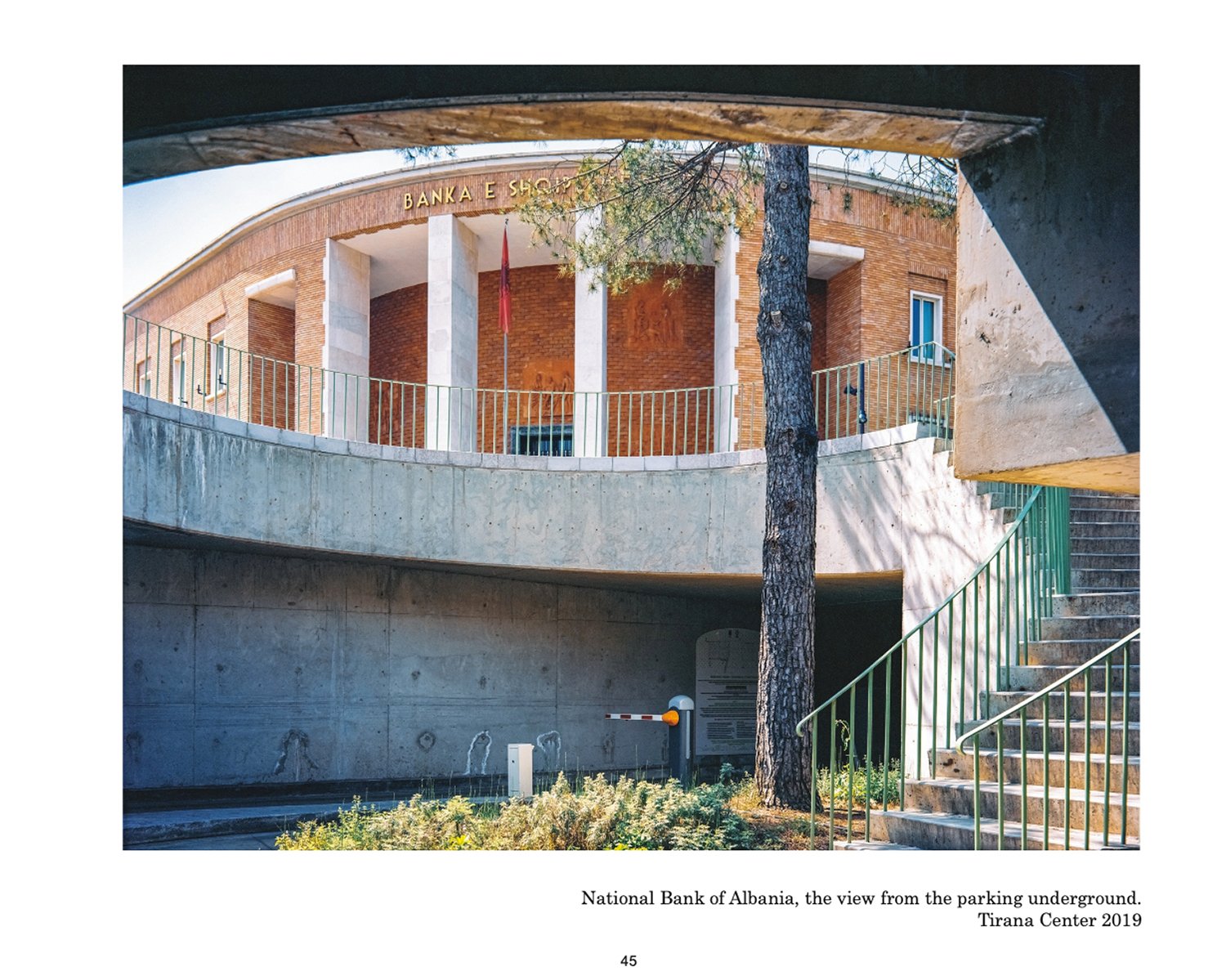
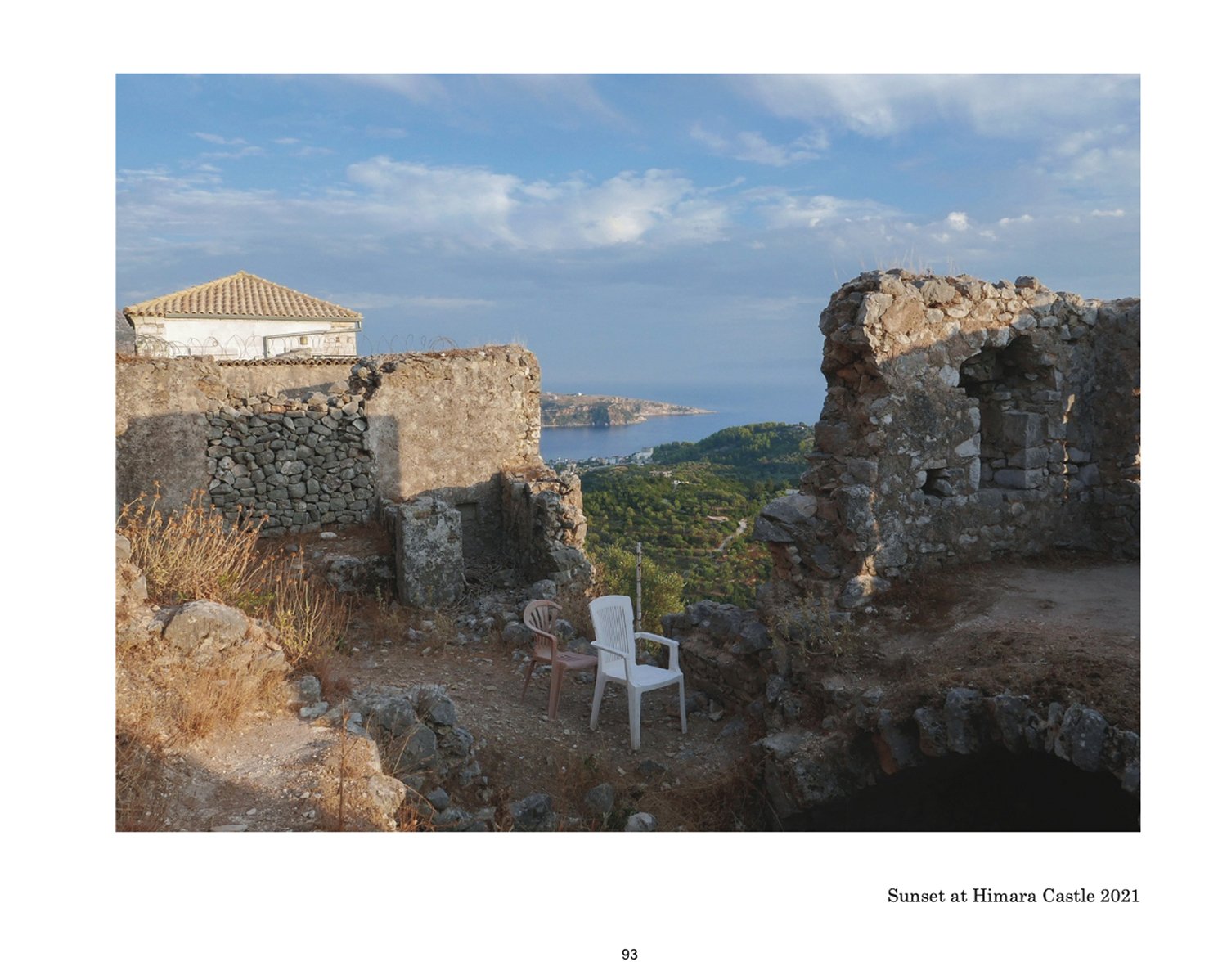
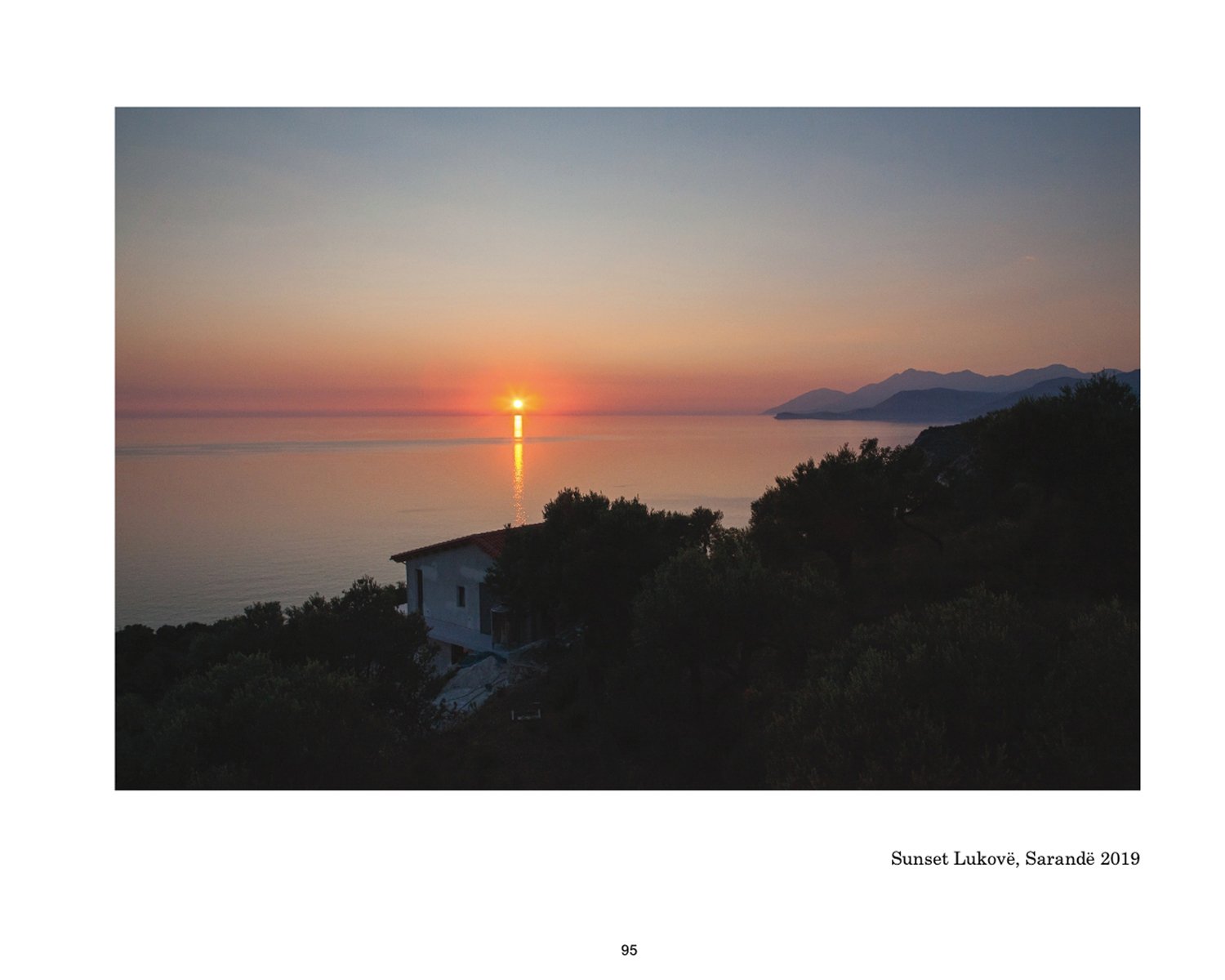
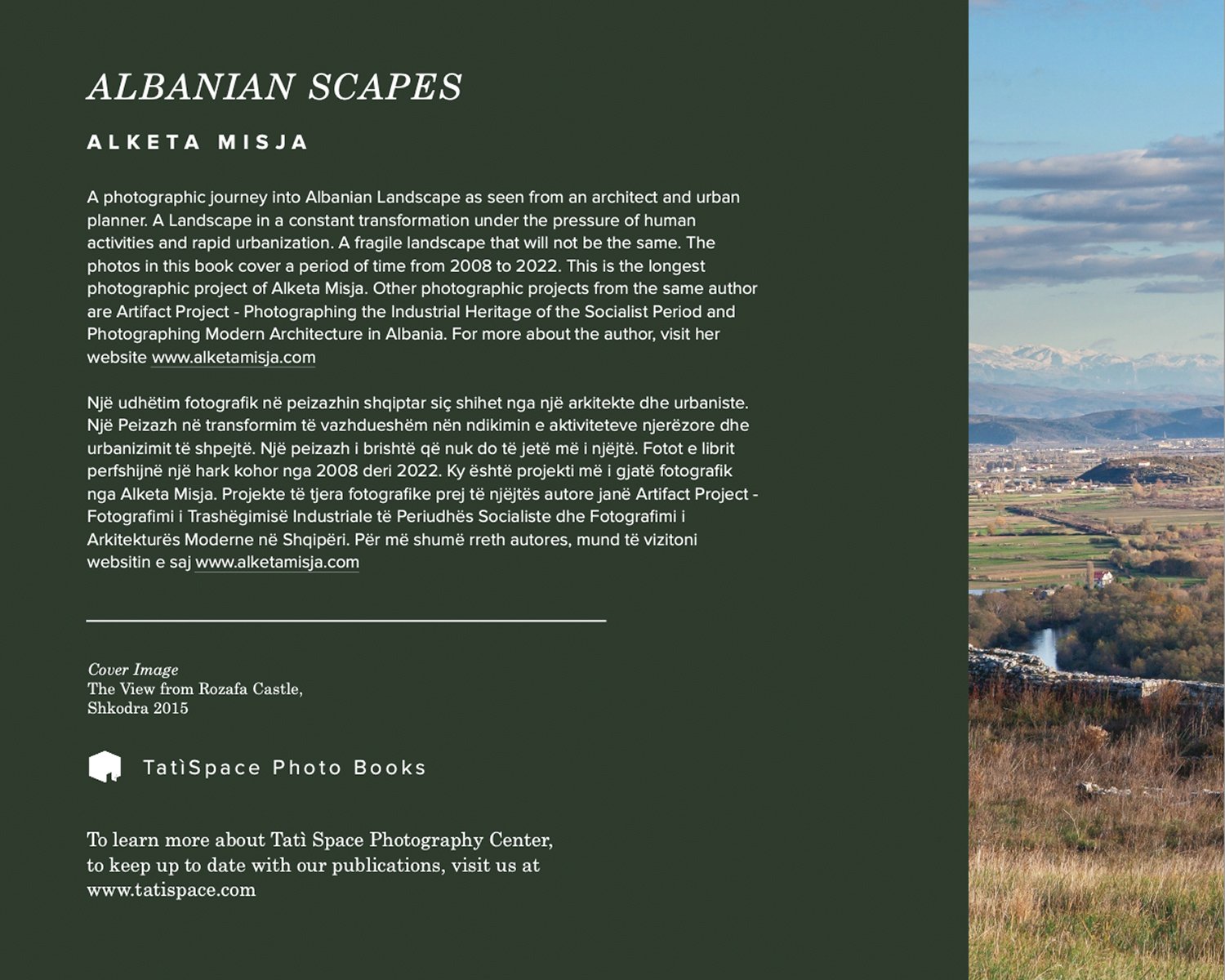
In her preface Landscape as Heritage, Falma Fshazi writes: “Through Alketa Misja's work, the landscape of Albania becomes an album made of hundreds of pages. Each photo is a small booklet of natural history, ecology, or urbanization. All together, the photographs document the Albanian heritage and landscape as heritage.
In the Albania of Albanian Scapes, we recall the cities that are permanently changing and increasingly occupied with tall buildings, bringing with it as many stories yet to be told. Many overlapping stories, managing to retain their individuality, much like the Albanian urban landscape whose transformation has continued with intensity toward the hills, plains and river banks, often entering where it does not belong, but unable to fundamentally alter the Mediterranean nature, the hospitable nature of the locals, or erase the traces of time.”
In his preface In Albania- Between Natural and Human Landscape, Andi Papastefani writes- “In this invaluable publication, Alketa Misja offers a depiction of this ongoing aesthetic, cultural, and ethical contrast. She portrays all of these juxtapositions in her photographic narrative about Albania as an architect and photographer, using iconic images that urge people to think and consider the true value of the landscape, culture, and history, as well as what we have lost.
The pleasing sights in this aesthetic edition captivate both the eye and mind. Unlike other publications on Albania that only highlight the natural beauty or, in other cases, merely the urban anarchy, Alketa has been able to draw attention to the complexity, contrast, and problems of this country with which nature has been so generous. This publication emphasizes the responsibility of society and residents to carry out daily activities with as little negative impact on nature as possible.”
"Journey beyond the horizon" - photography Meti Spahiu
In the rubric ‘Albanian Emergent Photographers’ in the field of architecture and urban photography, we bring the young Kosovar photographer Meti Spahiu, who for several years lives and works in Vienna, after his graduation as architect in the Technical Faculty TU WIEN.
In the rubric ‘Albanian Emergent Photographers’ in the field of architecture and urban photography, we bring the young Kosovar photographer Meti Spahiu, who for several years lives and works in Vienna, after his graduation as architect in the Technical Faculty TU WIEN. Meti Spahiu comes for the second time in TatiSpace, after his first presentation with the Photo Series in black & white untitled "Big Cities in my Eyes". This time, his photos are mostly in colour, but there are also black and white ones. The motif is the same- his favourite subject, the Architectural Photography of European cities, shot during his travels. Each of the photos brings back personal memories from cities like Innsbruck and Zurich. Other photographs were taken in Vienna, Munich, Bratislav. The author untitles the series "Journey beyond the Horizon" (dedicated to A.Sh). As he mentioned before, “The idea of my photographs is to bring beautiful images, to draw the public's attention to the aesthetic of the object photographed. I would like people, who pass every day carelessly near a building, to discover the beauty of its architecture when they see the photograph. For me, photography is a field that will never disappoint and that will go hand in hand with the profession of architect."
Allianz Arena, Munich, photography © Meti Spahiu
An den Kohlenrutschen 5, Vienna, photography © Meti Spahiu
Bratislava Bridge, Bratislava, photography © Meti Spahiu
Helmut Zilk Park 1100, Vienna, photography © Meti Spahiu
Odenburgerstrasse 19 1210, Vienna, photography © Meti Spahiu
Hofwiesenstrasse 16 78057, Zyrih , photography © Meti Spahiu
Schlachthausgasse 1030, Vienna, photography © Meti Spahiu
Subway Station Fröttmaning, Munich, photography © Meti Spahiu
Südbahnstrasse_Innsbruck, photography © Meti Spahiu
Taborstrasse 1020 Vienna, photography © Meti Spahiu
UBS Europaallee 23 8004 Zyrih, photography © Meti Spahiu
Hoch Zwei 1020, Vienna, photography © Meti Spahiu
Rozafa Shpuza
Rozafa Shpuza is a poet and a photographer, a uniqueness that creates a connection between two arts. She writes poetry in Gheg dialect, but she is as well productive in the field of photography, mainly in the genre of urban and street photography. Her photos are mostly shot in the streets of her hometown, Shkodra.
Rozafa Shpuza, Selfportrait
Rozafa Shpuza
(Albania 1969-)
Rozafa Shpuza is a poet and a photographer, a uniqueness that creates a connection between two arts. She writes poetry in Gheg dialect, but she is as well productive in the field of photography, mainly in the genre of urban and street photography. Her photos are mostly shot in the streets of her hometown, Shkodra. The subjects of her photography are urban moments of city scenes, captured in an abstract way, often surreal, with humor and well composed. The second photo gallery, perhaps the most important, is the portraits of the city dwellers, spontaneously shot in the public spaces, while performing activities or meditating in their tranquillity, captured unaware, creating a particular emotional state. What do city characters, silent passers-by, photographed in isolation, think in the midst of the urban chaos? It seems as if each of them is closed in their inner world, immersed in their thoughts and personal worries. In an individualistic society, where everyone thinks for themselves, Rozafa naturally seeks to penetrate the individual and his psychology. A third photo gallery, which I like very much, is the series of self-portraits on the streets of city, shot on sidewalks, shop windows or cafeterias, captured in superposition of different planes, alluding to a complex and confusing world in which the artist and the individual live in the modern city. Rozafa’s photographs, although unique in the Albanian photography scene, are nurtured by a rich international tradition of street photography, created and inspired by the photography of Walker Evans, Garry Winogrand, William Klein, Diane Arbus, Vivian Mayer, and others.
Below you can read a description that Rozafa Shpuza makes of her urban photography, given to TatiSpace. How did the creative process start, what was the beginning and the inspiration?
Rozafa Shpuza: Photography is a long-standing love of mine, which continues to inspire me and be an important part of my daily life. I have been dealing with photography for many years, sometimes more intensely and sometimes more calmly, and I can say without fear that photography has made my life beautiful. I bought my first camera in Denmark when I went to do a specialization course in 1994. The dynamics of that country, the architecture, the people, the different way of conceiving public spaces tempted me to fix all this on my incredibly modest camera. Since then I have not stopped. I photograph on the street because I feel that the characters I capture are real and convey the message of life without frames. Street photography is the most important part of my artistic creativity. I travel a lot because I feel like cities have a lot of surprises for my camera. The last album with street photos is the one I made in Shkodra during the isolation period of the Covid 19 pandemic. An empty city, scared characters in a hurry, closed windows and doors, all these sensations are already fixed in my album "The diary of an anxious season". I have participated in many activities dedicated to photography, in joint and personal exhibitions, at home and abroad, with the good desire to get to know photographer artists and to see where my photography stands compared to their photos. 3 years ago I opened an art gallery in Shkodra, at the old parents' house, with the good desire to promote artists from all over the world.
Urban Moments
© Rozafa Shpuza, Watery
© Rozafa Shpuza, Shkodra News
© Rozafa Shpuza, Shkodra
© Rozafa Shpuza, Kafja e Madhe, Shkodër
© Rozafa Shpuza, Showcase Approach
© Rozafa Shpuza, Selfportrait
© Rozafa Shpuza, Trille Vitrinash
© Rozafa Shpuza, No Smoking
© Rozafa Shpuza, Daily
© Rozafa Shpuza, The Floor F
© Rozafa Shpuza, Bike Repair
© Rozafa Shpuza, Chez Majlo, Gjilan
© Rozafa Shpuza, Pogradec
© Rozafa Shpuza, Nowhere
© Rozafa Shpuza, Communication, Koman Shkoder
© Rozafa Shpuza, Trumnajë bore
© Rozafa Shpuza, My Nowhere
Portraits of Passers-by
© Rozafa Shpuza,
© Rozafa Shpuza
© Rozafa Shpuza, showcase traps
© Rozafa Shpuza, Piano
© Rozafa Shpuza, Daily Time
© Rozafa Shpuza, Taxes that are forgiven
© Rozafa Shpuza, Children
© Rozafa Shpuza, Curiosity
© Rozafa Shpuza, The Walk
© Rozafa Shpuza, Icy Memories
© Rozafa Shpuza, Njomza
© Rozafa Shpuza, from the Series ‘Diary of an anxious season’
© Rozafa Shpuza, Time to pray, Shkodër
© Rozafa Shpuza, from the Series ‘Diary of an anxious season’
© Rozafa Shpuza, from the Series ‘Diary of an anxious season’
© Rozafa Shpuza
© Rozafa Shpuza, Wanderer
© Rozafa Shpuza, The Selector, from the Series ‘The Diary of an anxious season”
© Rozafa Shpuza, Lunch
© Rozafa Shpuza
© Rozafa Shpuza, Plisa
© Rozafa Shpuza, At ‘Dugajt e Reja’, Shkodër
© Rozafa Shpuza, the Neighbor
Color Photography
© Rozafa Shpuza, Salty twilight
© Rozafa Shpuza, Communication
© Rozafa Shpuza, Once Upon a Time
You can see more of Rozafa Shpuza photos, in her social media, Facebook, Instagram and Galleria Oda.
"Big cities in my eyes" - photography Meti Spahiu (English)
At TATÌ SPACE we are opening a new series of blogposts on Albanian emerging photographers in the field of Architectural Photography. Meti Spahiu is a recent graduate architect at the Technical Faculty of Vienna (TU WIEN), who pursues the passion of Architectural Photography. The subject of his photograph are the residential and commercial buildings in Vienna and other European cities.
At TATÌ SPACE we are opening a new series of blogposts on Albanian emerging photographers in the field of Architectural Photography. Meti Spahiu is a recent graduate architect at the Technical Faculty of Vienna (TU WIEN), who pursues the passion of Architectural Photography. The subject of his photographs are the residential and commercial buildings in Vienna and other European cities. Born in Kamenica, Kosovo, where he lived until the age of 25, Meti moved to study and live in Vienna, Austria. He sees his journey in architecture closely linked to photography. His black and white photographs express the verticality and horizontality in architecture, reinforcing the aesthetic of the building. As he says, “The idea of my photographs is to bring beautiful images, to draw the public's attention to the aesthetics of the objects photographed. I would like people who pass every day carelessly near a building to discover the beauty of its architecture when they see the photograph. "For me, photography is a field that will never disappoint and that will go hand in hand with the profession of architect."
City gate Aderklaaerstrasse - Vienna, © Meti Spahiu
Fernheizwerk Arsenal - Vienna, © Meti Spahiu
Harry SeidlerTurm - Vienna, © Meti Spahiu
JanisJoplin Promenade - Vienna, © Meti Spahiu
Leonard-Bernstein-Strasse - Vienna, © Meti Spahiu
Maintrain Station -Vienna, © Meti Spahiu
Olympiahalle 6020 Innsbruck, © Meti Spahiu
Strasse der Wiener Wirtschaft - Vienna, © Meti Spahiu
The stairs school “Eusebio da Guarda”, © Meti Spahiu
Via Dell’annunciata Milano, © Meti Spahiu




